- Manage Bookings
- Make an Enquiry

$1 £1 €1 Deposit
Book your dream destination with zero risk.
Secure your holiday with zero risk and change your departure date for free up to 30 days before. Booking Conditions apply . Tours depart from Spring 2021 through to 2022. Get excited and lock in your dream trip!
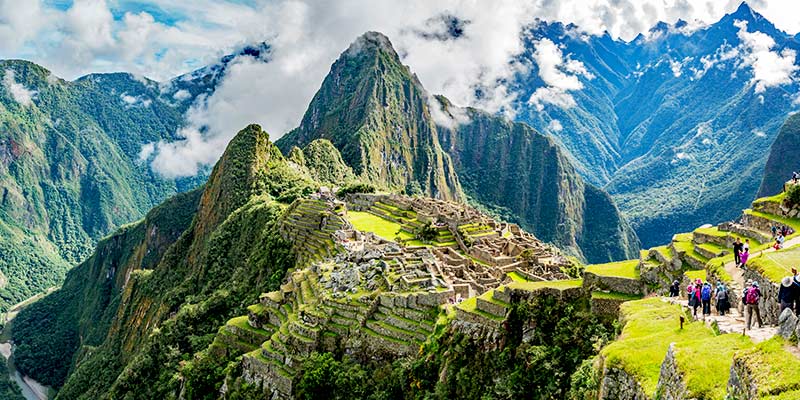
Adventure Tours with Tucan Travel
We have something for everyone, whether you are a solo traveller , travelling with friends or even a family looking for an adventurous getaway. We have wildlife trips , active adventures or escorted tours combining several different countries. Meet local communities, discover new cultures and enjoy an authentic experience travelling around the world.
Destinations we visit
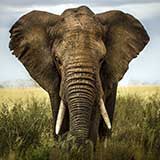
Central America

North Africa & the Middle East
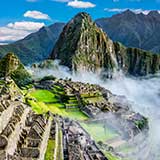
South America
Recommended Tours

Central Europe Highlights
Warsaw to Budapest
Tour Code: EEXC
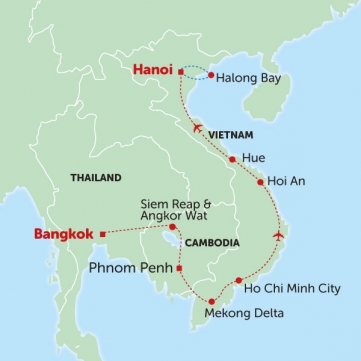
Cambodia & Vietnam Highlights
Bangkok to Hanoi
Tour Code: ICCV
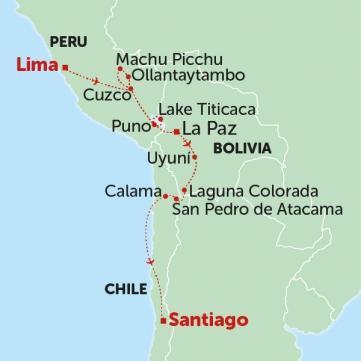
Peru, Bolivia & Chile
Lima to Santiago
Tour Code: HPC
$1 £1 €1 DEPOSIT
Dream Destination
with zero risk
Secure your holiday with zero risk and change your departure date for free up to 30 days before.
Tours depart from early 2021 through to 2022.
Booking Conditions Apply
Why choose Tucan Travel?
Amazing Prices
The majority of our tours include a Local Payment which keeps the total tour price low.
Award-Winning
We’re an award winning company, having won 6 awards last year!
33 years young
We have been operating since 1987 - 33 years of taking Tucan Travellers across the world.
Solo Travel
A whopping 60% of our passengers on our group tours are solo travellers.
Responsible & Sustainable
We adhere to a strict responsible travel policy and are committed to the welfare of wildlife.
Combinable Tours
Most of our tours are short sections of longer trips and can be combined to form an extended adventure.
This Cuba journey was one of the best
"This Cuba journey was one of the best short tours that I have made with a tour company Organisation was tops and the itinerary could not be faulted. Tucan Travel selected accommodation that allowed an insight into the Cubans' life. The hospitality was first class. I've kept note of other tours being offered and hope to travel again soon"
Derek O'Dell

Traveled to Antarctica with a Tucan
"Traveled to Antarctica with a Tucan partner. It was cheaper to book through Tucan than directly with the ship operator. Antarctica was fantastic, like going to another planet."
Amazing trip through Southern Africa
"Amazing trip through Southern Africa. We witnessed nature at it's most incredible with trips to Victoria Falls, the Okavango Delta and Etosha National Park. Staying in tents next to wild elephants in Botswana was a particular highlight. I would recommend this trip to anyone."
Archie Burgess

Tucan Travel Blog
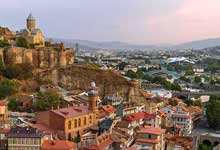
Underrated cities to visit in Europe
Sometimes the chaos of a popular tourist city is enough to make any traveller run for the hills. Long queues, crowded viewpoints, expensive ticket prices and sold out attractions.
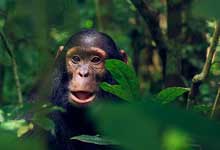
Best places to visit in February
From Carnival celebrations in Rio de Janeiro to the white sand beaches of Zanzibar. There are plenty of places to discover on your February holiday. 1. South Western Sri Lanka

Travel Trends 2021
It’s probably an understatement that 2020 has been a year like no other for the majority of us. Covid-19 has affected each and every one of us and impacted aspects of our lives we took for granted.
Visit the Tucan Travel Blog channel
Visit Tucan Travel's Youtube channel
Recent Awards
Back in 1987 Tucan Travel ran its first ever group tour through Colombia, South America - and this would be the first of many adventures across the globe! Over the last 33 years, Tucan Travel has brought travellers through Latin America, Africa, The Middle East, Asia and Europe. Whether it’s been trekking the Inca Trail to Machu Picchu, swimming through Mexican cenotes, watching lions on the prowl in Kenya or enjoying a bowl of pho in Vietnam, the experiences and memories made over the last three decades have created a wonderful community of like-minded travellers seeking authentic adventures.

Back to top
Independently Verified Travel Reviews From Past Clients
- Privacy Policy
Website & Online Bookings by Metafour
- Forgot your username?
- Forgot your password?
- AUD - Australian Dollar
- CAD - Canadian Dollar
- EUR - Euro
- GBP - Pound Sterling
- NZD - New Zealand Dollar
- USD - US Dollar
- Enter Costa Rica
- Travel Guide
- Popular Activities
- Wildlife Observation
- Toucans in Costa Rica
Toucans in Costa Rica: A Colorful Guide to These Tropical Birds
In Costa Rica's lush rainforests and diverse ecosystems, a captivating array of exotic wildlife finds its sanctuary. Among the vibrant residents of this tropical paradise, toucans emerge as some of the most iconic and charismatic avian species. Within this all-encompassing guide, we embark on a mesmerizing exploration of the realm of toucans in Costa Rica. This journey delves into their intriguing attributes, diverse species, distinctive behaviors, favored habitats, and prime destinations for witnessing these splendid birds in their unspoiled natural habitats.
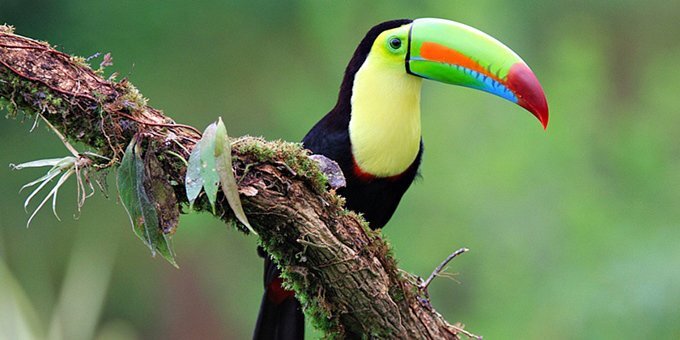
Free Vacation Planning
The importance of toucans in costa rica's ecosystem.
Toucans play a pivotal role in Costa Rica's rich and delicate ecosystem. These striking birds are vital seed dispersers, helping to maintain the health and diversity of the country's lush rainforests. As they feed on a variety of fruits, they inadvertently transport seeds to new locations, facilitating the growth of plants and trees. This process not only aids in forest regeneration but also supports countless other species that rely on these plants for food and shelter. Moreover, toucans contribute to the intricate web of life by serving as prey for larger predators, ensuring a balanced and thriving ecosystem. Their presence serves as a testament to the interconnectedness of all living beings in Costa Rica's biodiverse wonderland.
Toucan Species in Costa Rica
Costa Rica is home to several remarkable toucan species, each with its own distinctive characteristics and appearances. Here are some of the toucan species found in Costa Rica:

The above image was created by Costa-Rica-Guide.com . We encourage you to check out their site for carefully curated information about Costa Rica. Keel-Billed Toucan (Ramphastos sulfuratus): Often referred to as the "rainbow-billed toucan" due to its vibrant and striking bill, the Keel-Billed Toucan is an iconic resident of Costa Rica's rainforests. Recognizable by its large size and a bill that boasts a colorful palette of green, red, orange, and yellow, this toucan is known for its vocal nature and vibrant plumage. Chestnut-Mandibled Toucan (Ramphastos swainsonii): Known for its robust size and prominent chestnut-colored bill, the Chestnut-Mandibled Toucan is a common sight in Costa Rica's lowland rainforests. These toucans are known for their distinctive and resonant calls, often heard echoing through the dense foliage. Collared Aracari (Pteroglossus torquatus): While not a true toucan, the Collared Aracari is closely related and shares the same captivating appearance. Identified by its black plumage, yellow neck ring, and a striking blend of red and green on its head, this species can be spotted in various parts of Costa Rica, including the southern Pacific region. Fiery-Billed Aracari (Pteroglossus frantzii): Another aracari species found in Costa Rica, the Fiery-Billed Aracari is known for its fiery and vibrant bill. Its plumage features a mix of black, yellow, and red, making it a dazzling sight in the rainforest canopy. Emerald Toucanet (Aulacorhynchus prasinus): This smaller toucan species is recognized by its predominantly green plumage and striking emerald-colored throat. Although it's more commonly found in the highlands of Costa Rica, it's a beautiful and sought-after species by birdwatchers. Yellow-Eared Toucanet (Selenidera spectabilis): While not as frequently encountered as some other toucan species, the Yellow-Eared Toucanet is known for its distinctive yellow ear patches and green plumage. It's primarily found in the mountainous regions of Costa Rica. These toucan species contribute to the country's rich biodiversity, adding vibrant colors and captivating calls to the chorus of wildlife in Costa Rica's lush rainforests. Birdwatchers and nature enthusiasts flock to Costa Rica in the hopes of catching a glimpse of these charismatic and photogenic birds in their natural habitat.
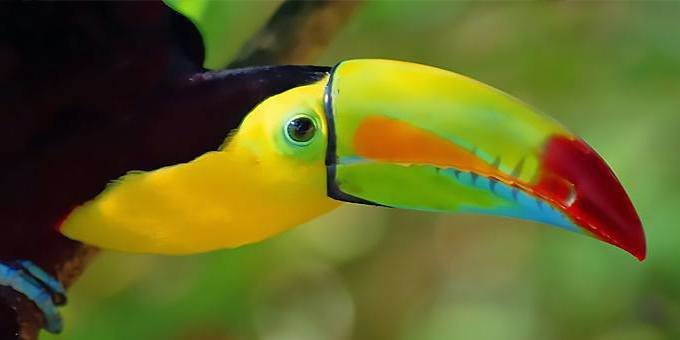
Toucan Behavior and Diet
Toucans in Costa Rica exhibit fascinating behavior and have a specialized diet that plays a crucial role in their ecological niche. Here's an overview of toucan behavior and their dietary preferences:
Social Creatures: Toucans are generally social birds and are often seen in small groups or pairs. Their social behavior includes mutual preening, bill-touching displays, and vocalizations to communicate with group members. Active During the Day: Toucans are diurnal birds, which means they are active during the daytime. They spend a significant portion of their day foraging for food, socializing, and engaging in other activities. They are most active and easy to find at dawn and dusk. Nesting Habits: Toucans nest in tree cavities, often using old woodpecker holes or natural hollows. They line their nests with leaves and may lay up to four eggs. Both parents take turns incubating the eggs and caring for the chicks. Flight: Toucans are strong fliers but are not known for long-distance flights. They primarily move through the forest canopy by hopping and gliding between branches. Vocalizations: Toucans are known for their distinctive calls. They use a variety of vocalizations to communicate with each other, including croaking, clucking, and squawking sounds. These calls are used for social bonding, territory defense, and mating.
Fruit-Eaters: Toucans are primarily frugivorous, which means they primarily feed on fruits. They have specially adapted bills that are designed for grasping and plucking fruits from tree branches. Varied Diet: While fruits make up a significant portion of their diet, toucans are opportunistic feeders. They also consume insects, small vertebrates like lizards and nestling birds, and even the eggs of other birds when the opportunity arises. Role in Seed Dispersal: Toucans play a crucial role in the ecosystem by aiding in seed dispersal. When they eat fruits, they often swallow seeds, which are later dispersed in different areas through their droppings. This helps in the regeneration of forests. Occasional Meat-Eating: Although fruits are their main food source, toucans are known to capture and eat insects, small reptiles, and nestlings, especially during the breeding season when they need additional protein for themselves and their chicks. Bill as a Tool: Toucans have large, colorful bills that are both an adaptation for feeding and a display of their health to potential mates. They use their bills to manipulate food items, toss them in the air, and catch them in their mouths. Toucans' vibrant appearance and interesting behavior make them a captivating subject for birdwatchers and wildlife enthusiasts. Their role in seed dispersal also makes them ecologically important in maintaining the health of Costa Rica's diverse rainforests.
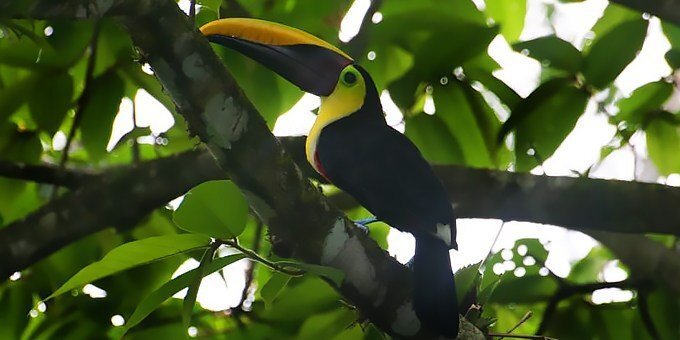
Habitats of Toucans in Costa Rica
Toucans in Costa Rica inhabit a variety of ecosystems, primarily tropical and subtropical forests, where they have adapted to specific niches within these habitats. Here are some of the key habitats where you can find toucans in Costa Rica: Lowland Rainforests: Lowland rainforests along both the Caribbean and Pacific coasts of Costa Rica are prime toucan habitats. These lush and biodiverse rainforests provide an abundance of fruit-bearing trees and a suitable environment for toucan species like the Keel-Billed Toucan and Chestnut-Mandibled Toucan. Montane Cloud Forests: The montane cloud forests found in regions like Monteverde and the Talamanca Mountains are also home to toucans. Here, the cooler and misty conditions provide a unique habitat for species like the Resplendent Quetzal and the elusive Highland Toucan. Tropical Dry Forests: In drier regions of Costa Rica, such as Guanacaste and parts of the Nicoya Peninsula, you can find toucans in tropical dry forests. These habitats are home to species like the Fiery-Billed Aracari and Collared Aracari, which have adapted to the seasonal changes in moisture. In particular, these birds can be found in higher numbers in the Rincon de la Vieja National Park. We would not recommend planning a trip around seeing toucans in the tropical dry forests, though, as they are in much higher numbers in the rainforests of Costa Rica. Edge Habitats: Toucans are often found in edge habitats, which are transitional areas between different ecosystems. Forest edges near rivers, clearings, or agricultural fields provide additional foraging opportunities for toucans. Protected Areas and National Parks: Toucans thrive in protected areas and national parks throughout Costa Rica. Parks like Corcovado National Park, Tortuguero National Park, Manuel Antonio National Park, and Cahuita National Park offer excellent toucan-watching opportunities within their diverse ecosystems. Fruit-Bearing Trees: Toucans are frequently spotted in areas with an abundance of fruit-bearing trees. They are attracted to areas where they can easily find their primary food source. Tree Cavities: For nesting, toucans often use tree cavities within their habitat. They seek out suitable trees with hollows for shelter and breeding. Canopy and Understory: Toucans are arboreal birds, meaning they spend most of their time in the tree canopy, where they can access fruits and other food sources. They are also known to forage in the understory and along the forest floor when searching for insects and other prey. Riparian Zones: Toucans are commonly found near water bodies like rivers and streams, especially during the dry season when water sources become crucial. These riparian zones provide additional habitat for foraging and drinking. Toucans are adaptable birds and can thrive in various forested environments, as long as they have access to a variety of fruits and suitable nesting sites. When exploring Costa Rica's diverse ecosystems, keep an eye out for toucans in these different habitats, and you'll likely have the opportunity to observe their vibrant plumage and interesting behaviors.
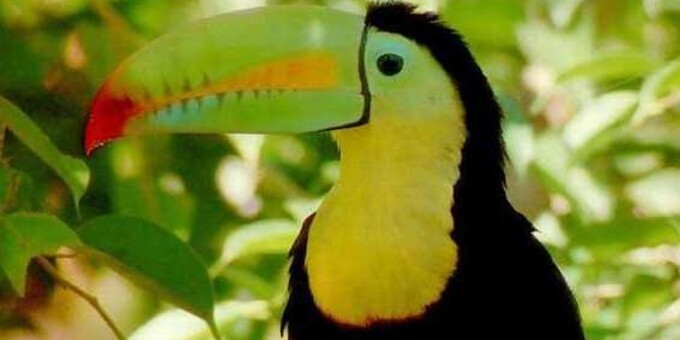
Top Toucan-Watching Locations in Costa Rica
Costa Rica offers numerous fantastic locations for toucan-watching, each with its unique charm and opportunities to observe these colorful birds in their natural habitats. Here are some of the top toucan-watching locations in Costa Rica: Monteverde Cloud Forest Reserve: Located in the Monteverde region, this cloud forest reserve is renowned for its biodiversity, including various toucan species like the Resplendent Quetzal, the Keel-Billed Toucan, and the Emerald Toucanet. Guided tours through the reserve often lead to close encounters with these striking birds. Tortuguero National Park: Situated on the Caribbean coast, Tortuguero is not only famous for its sea turtles but also for its diverse birdlife, including toucans. Explore the park's network of canals and lush rainforests to spot Chestnut-Mandibled Toucans and Collared Aracaris. Manuel Antonio National Park: On the Pacific coast, Manuel Antonio National Park is a wildlife-rich area where you can often spot toucans, especially the Fiery-Billed Aracari and Collared Aracari. Trails within the park provide excellent opportunities for birdwatching. Corcovado National Park: Located on the Osa Peninsula, Corcovado is a biodiversity hotspot and one of the best places to witness toucans in their natural habitat. Keel-Billed Toucans and Yellow-Eared Toucanets are commonly seen here. Cahuita National Park and the Southern Caribbean Coast: This region on the Caribbean coast offers a mix of rainforest and beach habitats, attracting toucans like the Chestnut-Mandibled Toucan. Guided hikes through Cahuita National Park are ideal for birdwatching. Arenal Volcano National Park: The Arenal area is known for its volcanic landscapes and lush forests. Explore the park's trails and canopy tours to spot the Keel-Billed Toucan and other avian species. La Selva Biological Station: This research station in Sarapiqui is a hotspot for birdwatching. It provides a controlled environment for observing a wide range of bird species, including various toucans. La Fortuna: The town of La Fortuna near Arenal Volcano offers various birdwatching tours, which often include encounters with toucans. Keep an eye out for toucans in the trees and gardens around the town. Costa Ballena: Along the southern Pacific coast, the Costa Ballena region is a great place to observe toucans, especially in the dense forests of Marino Ballena National Park and the surrounding areas. Sarapiqui: The Sarapiqui region is home to several birdwatching lodges and reserves, making it an excellent destination to spot toucans. The Collared Aracari is frequently seen in this area. Remember that the best chances of spotting toucans are often during the early morning and late afternoon when they are active. Hiring a local birdwatching guide or participating in organized birdwatching tours can significantly enhance your toucan-watching experience in Costa Rica. These experts have an intimate knowledge of toucan habitats and behaviors, increasing your chances of memorable encounters with these charismatic birds.
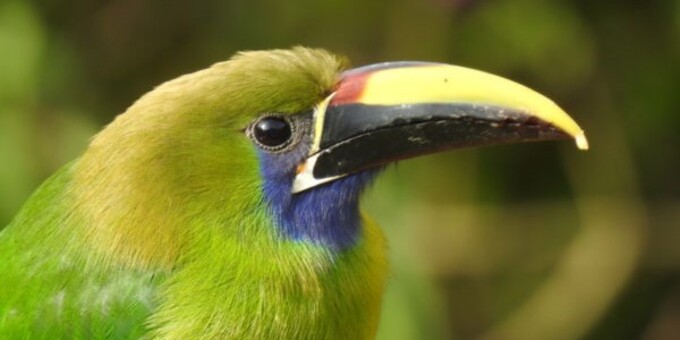
Encountering Toucans: Where to Find Them & Tips for Birdwatchers
Toucans are among the most captivating and iconic birds you can encounter in the forests of Central and South America. Known for their vibrant plumage and distinctive large bills, these birds have a unique charm that draws birdwatchers from around the world. Here are some tips for birdwatchers looking to encounter toucans in their natural habitat: Choose the Right Location: Toucans inhabit a range of forested habitats, from lowland rainforests to montane cloud forests. Research the specific species of toucan you want to see and their preferred habitat, then choose your birdwatching location accordingly. Costa Rica, Panama, and parts of the Amazon rainforest are renowned for their toucan populations. Timing Matters: Toucans are generally more active during the early morning and late afternoon. Plan your birdwatching outings during these times for the best chances of spotting them. Learn Their Calls: Toucans are known for their loud, croaking calls. Familiarize yourself with the calls of the toucan species you're hoping to see. This can help you locate them more easily, as their calls often give away their presence. ebird.org has great recordings you can listen to and learn . Pack the Right Gear: A good pair of binoculars and a field guide specific to the region you're visiting are essential for birdwatching. Toucans can sometimes be high in the canopy, so binoculars with good magnification are crucial. Be Patient: Birdwatching, especially in dense forests, requires patience. Toucans can be elusive and may take some time to spot. Spend time quietly observing their habitat, and you may be rewarded with a sighting. Respect Their Habitat: Toucans are most active in their natural habitat. When birdwatching, be respectful of the environment. Stay on designated trails and avoid disturbing nests or sensitive areas. Join a Guided Tour: If you're new to birdwatching or the area you're visiting, consider joining a guided birdwatching tour. Local guides often have expert knowledge and can increase your chances of spotting toucans. Record Your Observations: Keep a birdwatching journal or use a birding app to record your toucan sightings. Note the location, time, and any interesting behaviors you observe. This can be a valuable reference for future trips. Learn About Their Behavior: Understanding toucan behavior can enhance your birdwatching experience. Toucans are frugivorous, so knowing their diet can help you predict where they might be foraging. Practice Ethical Birdwatching: Always practice ethical birdwatching by maintaining a safe and respectful distance from the birds. Never try to touch or feed them, as this can disrupt their natural behaviors. Encountering toucans in the wild is a memorable experience for any birdwatcher. With the right preparation, patience, and respect for these remarkable birds and their habitats, you can enjoy the thrill of spotting toucans in their natural environment.
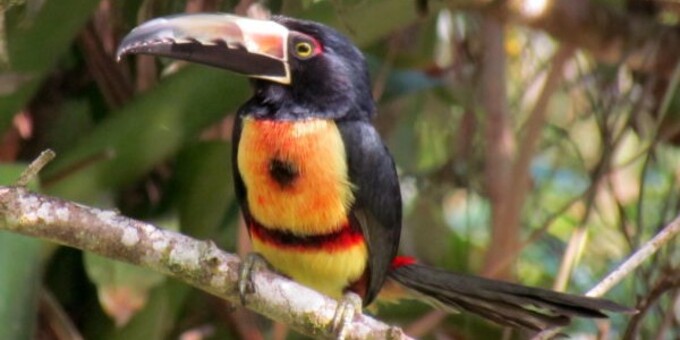
Toucan Trivia and Fun Facts
Toucans are fascinating birds with a range of intriguing characteristics. Here are some toucan trivia and fun facts: Fruit Lovers: Toucans are primarily frugivorous, which means they primarily eat fruits. Their large bills are adapted for grasping and eating a variety of fruits, and they play an essential role in dispersing seeds in tropical forests. Diverse Diet: While fruits make up the majority of their diet, toucans are not picky eaters. They also consume insects, small vertebrates, and even bird eggs when the opportunity arises. Vibrant Plumage: Toucans are known for their striking and colorful plumage. Their vibrant feathers come in a variety of colors, including bright reds, blues, and yellows, making them some of the most visually appealing birds in the avian world. Keen Eyesight: Toucans have excellent eyesight, which is crucial for finding and identifying their food sources high in the canopy. Their eyes are surrounded by bare, brightly colored skin, giving them a unique appearance. Unusual Bill: The toucan's bill, despite its large size, is relatively lightweight due to its hollow structure. It's composed of a bony core covered in keratin, the same protein that makes up human hair and nails. Limited Vocalizations: Toucans are not known for their vocal prowess. They have simple, croaking calls that are often used for communication within their social groups. These calls are quite distinctive and can be used to identify different species of toucans. Family-Oriented: Toucans are social birds and often live in small family groups. They are known for their playful interactions and the sharing of food among group members. Flying Skills: Despite their large bills, toucans are skilled flyers. They have strong wing muscles that allow them to navigate through the dense forests where they live. Nesting Behavior: Toucans nest in tree cavities, often using natural hollows or abandoned woodpecker nests. They may also enlarge these cavities using their bills. The female typically lays two to four eggs, and both parents take turns incubating them. Conservation Concerns: While some toucan species are thriving, others are facing habitat loss and poaching pressures. The toco toucan, one of the most recognizable species, is considered of "Least Concern" by the IUCN, but conservation efforts are ongoing to protect their habitats. These fun facts shed light on the remarkable world of toucans, highlighting their unique adaptations, behaviors, and the important ecological roles they play in their tropical forest ecosystems.
Unsure of what to do? Let us make you a free custom trip plan!

Costa Rica is the number one destination for Adventure Travel
Would you like some adventure and adrenaline combined with nature and wildlife, Costa Rica is the perfect destination.
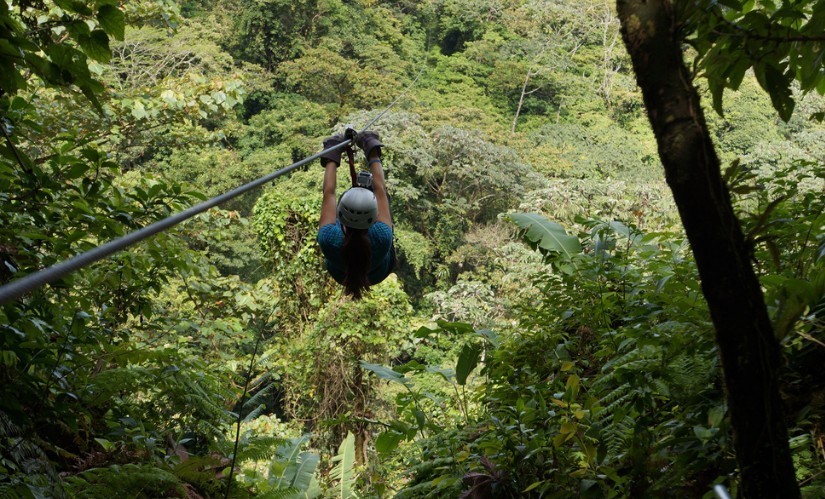
Costa Rica offers some world famous spots to go wild water rafting. Go for a day trip of combine your rafting adventure over two days or more with an overnight trip combined with lodging in the middle of the rainforest. Pacuare river is among the world’s best rivers to go rafting because of the amazing natural beauty and technicality of the river.
White water rafting is a popular adventure activity in Costa Rica, where there are several rivers that offer varying levels of difficulty for rafters of all abilities. The most popular rivers for rafting in Costa Rica include the Pacuare River, Sarapiquí River, Savegre River, Reventazón River, and Naranjo River. The Pacuare River is considered one of the best white water rafting rivers in the world and offers a thrilling adventure with numerous Class III and IV rapids. The Sarapiquí River is also a popular option with Class III and IV rapids and is suitable for both experienced and novice rafters. The Savegre River is known for its spectacular scenery and offers a more leisurely rafting experience with Class II and III rapids. The Reventazón River has both Class III and IV rapids and is a great option for intermediate rafters. The Naranjo River is a more challenging river with Class IV and V rapids and is best suited for experienced rafters. Most white water rafting tours in Costa Rica include trained guides, safety gear, and equipment, and can be arranged through tour operators in popular tourist areas like La Fortuna, Manuel Antonio, and San Jose. It is recommended to book a tour in advance and choose a reputable tour operator with experienced guides to ensure a safe and enjoyable rafting experience.
Canyoning, also known as canyoneering, is a popular adventure activity in Costa Rica. It involves exploring canyons and gorges by walking, climbing, jumping, rappelling, and swimming through waterfalls, pools, and streams. The country has many canyoning tours and destinations available, spread throughout different regions. Some of the best-known canyoning spots in Costa Rica are located in Arenal, Monteverde, Dominical, and Jaco. The tours are usually guided, and a typical excursion last around 3-4 hours. The tour companies provide the necessary gear and equipment such as helmets, harnesses, and ropes. Canyoning in Costa Rica is accessible for all skill levels, from beginners to advanced. It is a great way to experience the country’s stunning natural scenery and enjoy outdoor adventure. However, some tours require a certain level of physical fitness and may not be suitable for everyone. Safety is always a top priority, and all the tour companies follow strict safety guidelines and procedures to ensure a safe and enjoyable experience for all participants. If you are interested in Canyoning in Costa Rica, research different tour companies to find one that fit your preferences and skill level. Make sure to read reviews and ratings of each company, and always follow the instructions of your guide for a safe and enjoyable experience.
Tubing in Costa Rica is a popular adventure activity that involves floating down river rapids in an inflatable tube. It can be enjoyed by individuals of all ages and is a great way to experience the beauty of Costa Rica’s river and jungle environments. There are several tubing locations throughout Costa Rica, with some of the most popular being the Rio Negro, Rio Colorado, and the Sarapiqui River. Each location offers unique experiences, from calm and easy-going rivers to more challenging rapids. Tubing tours usually include transportation to and from the river, safety equipment, and a guide who will lead the group down the river. Some tours may also include other activities such as zip-lining or waterfalls. When planning a tubing excursion, it is important to pack sunscreen, water shoes, and a change of dry clothes. It is also recommended to check weather conditions and river levels to ensure the safety of the activity. Overall, tubing in Costa Rica is a fun and exciting way to explore the country’s natural beauty and is a must-do activity for adventure seekers.
Costa Rica is known for its beautiful beaches and crystal-clear waters, making it an ideal destination for snorkeling enthusiasts. Here are some of the best places to go snorkeling in Costa Rica:
Caño Island – Considered as one of the best snorkeling spots in Costa Rica, Caño Island has crystal-clear waters and a rich marine life. You can see different species of fish, sharks, dolphins, sea turtles, and octopuses.
Manuel Antonio – Located in the Central Pacific coast of Costa Rica, Manuel Antonio has a diverse marine life and coral reefs. You can see angelfish, pufferfish, parrotfish, and much more.
Tortuga Island – This beautiful island has a mixture of sandy beaches and coral reefs. You can find different species of fish, manta rays, and even whales in the area.
Bat Islands – This remote snorkeling spot is located off the coast of Guanacaste province. Bat Island is known for its strong currents and a diverse marine life including giant manta rays, bull sharks, and humpback whales.
Before heading out to snorkel in Costa Rica, it’s important to keep the following in mind:
Always snorkel with a buddy and never alone Wear protective gear like wetsuits and fins Don’t touch the marine life Don’t litter, and take any trash with you Respect the natural environment and wildlife. Overall, Costa Rica’s beaches and underwater world offer an unforgettable experience for any snorkeling lover.
National Parks: Costa Rica has more than 30 national parks where you can go hiking. Some of the popular national parks for hiking are Corcovado National Park, Arenal National Park, and Manuel Antonio National Park.
Climate: Costa Rica has a tropical climate with two seasons- dry and rainy. The dry season is from December to April, and the rainy season is from May to November. The best time to go hiking is during the dry season when the trails are dry.
Trail difficulty: Costa Rica has a mix of easy, moderate, and challenging trails. If you’re a beginner, you can try hiking to La Fortuna Waterfall or Monteverde Cloud Forest Reserve. For experienced hikers, the challenging trails of Corcovado National Park or Cerro Chirripo will offer a great experience.
Wildlife: Costa Rica has a rich variety of fauna and flora. As you hike, you can encounter exotic animals like monkeys, sloths, toucans, and snakes. Make sure to carry a camera to capture these beautiful moments.
Safety: Hiking in Costa Rica requires you to be careful and cautious. Make sure to carry enough water, wear comfortable and sturdy shoes, and follow the trail signs. Also, avoid hiking alone, especially in remote areas.
Guided hikes: If you’re unsure of the hiking trails, you can hire a professional guide to accompany you. They will provide you with additional knowledge of the flora, fauna, and history of the area.
Overall, hiking in Costa Rica is a must-do activity for nature lovers. With its lush forests, exotic wildlife, and diverse landscapes, it’s an experience that will stay with you for life.
Mountain biking in Costa Rica is a popular adventure activity for both locals and tourists. The country has a diverse range of terrains to offer, including dense forests, rocky terrains, and challenging trails. Here are some key points to know about mountain biking in Costa Rica:
Trails: There are over 400 trails in Costa Rica, ranging from easy to difficult levels. Some of the most popular trails include the La Paz Waterfall Gardens Trail, Irazu Volcano Trail, and Monteverde Cloud Forest Reserve Trail.
Guided tours: Many tour operators in Costa Rica offer mountain biking tours. It is always recommended to go for a guided tour to ensure safety and get the most out of the experience.
Biking season: The best time to go mountain biking in Costa Rica is from November to April, which is the dry season. However, biking is possible all year round, but it might be challenging during the wet season (May-October).
Equipment: Many bike shops in Costa Rica offer rentals and repairs. However, it is always recommended to bring your own equipment for better comfort and safety.
Safety: It is important to wear a helmet and proper biking gear to avoid any injuries. It is also best to stick to the trails and not venture into unknown areas.
Cost: The cost of renting a bike in Costa Rica starts at approximately $25 per day, and guided tours can cost anywhere between $50 to $150 depending on the duration and location.
Overall, mountain biking in Costa Rica offers an exciting and unique way to explore the country’s natural beauty while getting your adrenaline pumping.
Costa Rica is known for its beautiful landscapes and diverse wildlife, making it a great destination for horseback riding. Here are some things to know:
There are many riding tours available in different regions of the country, such as the Arenal Volcano, Monteverde Cloud Forest, or the beaches of Guanacaste. The tours are typically led by experienced guides who can take riders through forests, up mountains, and along rivers and other scenic spots. The horses used are often well-trained and healthy, and are selected for each rider based on experience and skill level. Many tours offer the option of riding for several hours or even days, and may include camping or other amenities. It is important to wear appropriate clothing, including long pants and closed-toe shoes, as well as hats and sunscreen to protect against the sun. Some tours may also include meals, drinks, and other activities, such as zip-lining or swimming in natural springs. Overall, horseback riding is a fun and unique way to explore the natural beauty of Costa Rica. Just make sure to choose a reputable tour operator and follow safety guidelines to ensure a memorable and safe experience.
Canopy tours are one of the most popular adventure activities in Costa Rica. They involve ziplining from platform to platform while suspended high above the ground in the forest canopy.
Here are some key things to know about canopy tours in Costa Rica:
Safety: Canopy tour operators in Costa Rica are required to follow strict safety regulations. This includes regular equipment inspections and staff training. Always check that the operator has all the permits and certifications required by the government.
Locations: There are many locations in Costa Rica where you can experience a canopy tour. Some of the most popular ones are in the Monteverde Cloud Forest, Arenal Volcano, and Manuel Antonio National Park.
Length and height: Canopy tours vary in length and height. Some tours have only a few ziplines while others have dozens. Heights can range from a few meters to over 100 meters.
Cost: The cost of canopy tours in Costa Rica ranges from around $50 to $100 per person. Prices can vary depending on the location, the number of ziplines, and the duration of the tour.
Health requirements: Canopy tours require some degree of physical fitness. You should be able to walk up stairs and hills and be able to support your own weight on the zipline equipment. Some companies have weight restrictions for safety reasons.
What to bring: Wear comfortable clothes and closed-toe shoes with good traction. Sunscreen, insect repellent, and a hat are recommended. Most tours provide helmets and other safety gear.
Overall, canopy tours are a thrilling and unique way to experience the beauty of Costa Rica’s forests and wildlife. Just make sure to do your research and choose a reputable and safe operator.

Costa Rica Guide
Travel information and maps, toucans in costa rica.
Toucans are among the cutest vicious killers in the world. Yup. That colorful little guy on the Froot Loops box is really a cold blooded assassin.
find toucans? | toucanets | aracaris | froot loops | wildlife
While fruit is a staple of their diet they actively hunt other animals including tarantulas, lizards and other birds – especially eggs and hatchlings from nests.
When we visited the Osa Wildlife rescue we heard a tale (backed up by a scar) of a toucan actually attacking a human. Plummeting like a missile from a branch leading with it’s spear like beak the volunteer said the bird was targeting his eye intentionally to try to get the tray of fruit he was delivering from the kitchen to one of the wildlife rehab enclosures.
They are known to attack their own kind as well. Chestnut-mandibled ( Ramphastos ambiguus swainsonii – a subspecies of the yellow-throated) toucans are considerably larger than their cousins the Keel-billed ( Ramphastos sulfuratos – froot loops toucan) and will follow their calls to feeding trees and drive them off to steal a meal.
There are six birds in Costa Rica that have the unmistakable outline of a toucan with the dramatic bill projecting far out in front though technically two of them are toucanets, and two others aracaris.
The Toucans of Costa Rica

In English the Chestnut-mandibled toucan has more names than we can keep track of it may also be called the black-billed, Swainson’s, or Yellow-fronted toucan. The latin name is Ramphastos ambiguus swainsonii and in Spanish they are always known as Dios-te-de (God gives you) because it sounds like that’s what the birds are saying when they call.
They nest in existing tree holes (often abandoned by woodpeckers) because their beaks are not strong enough to hammer through wood. Babies hatch just two weeks after the eggs are laid. They are mainly frugivores and will protect mini-territories consisting of a few branches in a tree where fruit is ripening. Males sometimes generously contribute their leftovers to their mates by leaving a good feeding spot when she arrives.
They are also opportunistic and will eat frogs, lizards, insects, baby birds and eggs to supplement the fruits.
Yellow front or chestnut they are the largest toucan in Costa Rica and sort of bullies. Flocks acting more like gangs will find keel-billed toucans feeding spots and drive their smaller cousins away.

The Spanish name for the keel bill is much more fun and evocative – tucán pico arcoiris – the rainbow beak toucan.
They are the clowns of the bird kingdom and can be seen playing with their food in the treetops. Not only is it common to see them tossing a small fruit in the air and catching it themselves but they’ll also toss one up for their neighbor like teenagers with pop-corn. They cram an extended family or small flock into one or two nest holes and are constantly tumbling and sword dueling with their oversized beaks.
Their range overlaps with the Chestnut-mandible toucan on the Caribbean side but extends into the northern Pacific as well. The keel-billed and collared Aracari are the only toucans found on the Nicoya peninsula.
The Aracaris Living in Costa Rica
The Collard Aracari (Spanish – tucancillo ollarejo ) and Fiery-billed Aracari (Spanish – tucancillo piquianaranjado ) are very similar in appearance but you’ll always know which is which based on where you are. As seen on the range map below the collard are in the Caribbean and across the north through Guanacaste and the Nicoya peninsula while their fire billed cousins stay on the south Pacific and Osa.

The Toucanets Native to Costa Rica
There are two toucanet species in Costa Rica and they’re much more difficult to spot than their larger and more gregarious cousins.
Our personal favorite is the emerald or blue-throated toucanet. It could be because they hang out at higher elevations (usually above 1,000 meters, 3,300 feet) in our favorite places to hike like Monteverde , San Gerardo and Chirripo . Not do they live higher than any other toucan they are also the species that appears the farthest north reaching into central Mexico.

The yellow-eared toucanet inhabits a narrow strip of low to mid elevation rain forest on the east side of the continental divide (see map). Their range extended across the Caribbean lowlands before all the forest was clear cut for pasture and pineapple plantations.
They are rare and inhabit the canopy moving into the lower branches occasionally. They avoid open areas which makes them very challenging to see especially with the severe reduction of their habitat in Costa Rica. Their call sounds like a series of rapid clicks almost as though someone was rubbing a stick across the ridges of a maraca.
They are the only members of the toucan family in Costa Rica where the females and males are obviously different in coloration. Only the males have the “yellow ears.”

How to Find Toucans In Costa Rica?
Almost no matter where you are in Costa Rica there’s at least one species of toucan around.

In our experience the easiest place to find toucans is in the foothills and low mountains of the central and south Pacific and Osa Peninsula where the range of the yellow-throated/chestnut toucan and fiery-billed aracari overlap. Both are very common and especially the chestnut are very loud. We’ve seen over a hundred of the two species combined in a couple hours of walking in the hills above Hermosa/Jacó .
Another fantastic place to see toucans is around Arenal volcano . There aren’t nearly as many total birds as there seem to be along the central Pacific but it’s one of the few places where you can see five different species.
Keel-bills are fairly common but La Fortuna and Arenal are on the edge of the range map for chestnut-mandible toucans and blue-throated (emerald) toucanets and smack in the middle of the best places to see collard-aracaris and yellow-eared toucanets. Only the Fiery-bill is missing.
Although it’s one of the best places don’t hold your breath for a toucan pentathlon because the yellow-eared toucanet is still definitely the hardest of all to see. We’ve spotted one in 25 years. Yellow-eared toucanet, aka Cassin’s aracari ( Selenidera spectabilis ) tucán orejiamarillo
Blue-throated toucanet, aka Emerald toucanet ( Aulacorhynchus caeruleogularis ) tucanete gorjiazul

Froot Loops – Toucan Sam
I always use Toucan Sam to help people picture the Keel Billed species, “you know, the Froot Loops Toucan” and when I automatically typed “Froot” it looked weird so I googled it. Sure enough, it’s “oot” not “uit” probably because they contain zero fruit.

Wikipedia told me all sorts of things I couldn’t have known when I was a kid listening to Mel Blanc (him I knew from Bugs Bunny and Porky Pig fame) give him voice “Follow my nose! It always knows!” I remember debating my brothers and sister about the flavors and whether the red ones tasted like cherry or strawberry. It was obvious that orange was orange and yellow was lemon (green, blue and purple weren’t added for another 30 years in the ’90s).
I don’t remember who it was that insisted they’re all the same flavor but whoever it was got it right…
Villa Tucan La Fortuna

Welcome to Villa Tucan
Villa Tucan is a small slice of jungle paradise located in La Fortuna, Costa Rica. Here you’ll find the perfect blend of everything nature has to offer and a prime location near all the main attractions of the area. Come enjoy a calming atmosphere with your significant other, friends or family while exploring the region’s magical sights and sounds.

Exclusive Offer
Get 15% off your first trip.
Who doesn’t like a discount? Book with us your first trip today and receive an exclusive offer.
Share this:

- Copy shortlink
- Report this content
- Manage subscriptions
Emergency Banner Component
Costa Rica: Jungles & Rainforests
Select Year
Select the year you would like to travel.
- 2024 Classic
- 2025 Classic
Accommodations
- Pricing & Availability
- Important Info
Uniquely Tauck
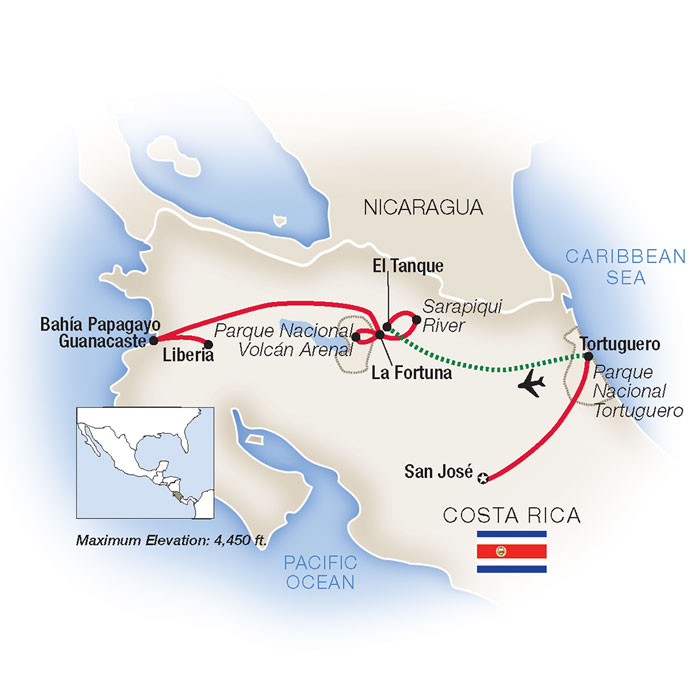
EXPERIENCE WITH TAUCK
TAUCK EXCLUSIVE – Explore the wilderness with wildlife experts who help you spot sloths, monkeys, and other local creatures on a jungle river-rafting adventure and a canal boat cruise in Tortuguero National Park
Go coastal during your two-night stay on the Gulf of Papagayo where snorkeling adventures open your eyes to an underwater world alive with tropical fish, manta and eagle rays, coral, sea urchins, pufferfish, turtles, trumpetfish – and dolphins
TAUCK VALUE INCLUDES
On-tour air included (1 flight).
Zip line adventure for extraordinary views of Arenal Volcano and the lush rainforest canopy
Guided pineapple tour includes tastings of field-fresh pineapples and pineapple treats
Hands-on demonstration in making chocolate
SEE WHAT YOUR JOURNEY INCLUDES
Active components such as hiking, bicycling and walking longer distances may be included, and hills and/or uneven terrain may be encountered on several days. Guests should be able to walk two to three miles and stand for long periods of time with no difficulty.
Often robust – may include long days, active sightseeing, early starts, evening activities, significant travel times.
World Travel. Family Discovery.
Life is pretty colorful on a Costa Rica family vacation, where even butterflies like the electric-blue morpho make visitors gape in awe.
Your family's adventures in the rainforest.
Days 4 and 5
Adventures in an eco-paradise
Since its last noticeable activity in 2010, Costa Rica's cone-shaped Arenal Volcano has been "sleeping," but it's still a breathtaking sight – especially when seen from the bird's-eye view you'll have during your thrilling zip-line ride over the rainforest canopy at Sky Trek Adventure Park (voted "Best Zip-lining Tour in Costa Rica" by Travel + Leisure). And if that's not enough adventure for your family, board a river raft for a Class II rafting trip through the jungle; try to spot turtles, sloths, monkeys, iguanas and other wildlife along the riverbank that call the Sarapiqui region home.
Costa Rica & the Greatest Wildlife on Earth
insideTauck Presentation
Join us for a presentation from Tauck partner Tim Martin, TV executive producer, wildlife photographer and conservationist.
Tim will be speaking about the "greatest wildlife on Earth," a journey from Costa Rica's Caribbean to Pacific coasts. He'll speak about the conservation efforts and restoration of forests along with insight into the diverse wildlife of this destination – an overview of Costa Rica and his 20+ year filmmaking experience.
Watch Video
Feathered friends at the Toucan Rescue Center
Wildlife friends on the mend.
While they often tend to be elusive in the wild, you can see an exotic parade of animals and birds during your guided visit to the Toucan Rescue Ranch, dedicated to the rescue and rehabilitation of jungle and rainforest animals. You'll meet a variety of furred and feathered friends that reside at the ranch… including sloths, monkeys and parrots, and of course, the toucans they successfully breed here.
Eco-discoveries in Tortuguero National Park
Tortuguero and its wonders.
The canals of Costa Rica's Tortuguero National Park are lined by a wildlife-rich tropical rainforest that howler and spider monkeys, three-toed sloths, toucans, great green macaws, tapir, ocelots, jaguars, river otters, grisons, frogs and bulldog bats call home. As you cruise these waterways with our local guides, you'll also find coconut trees, orchids, heliconias and other flora that add tropical color everywhere you look. And since the park is also one of the world's top nesting grounds for endangered green sea turtles in summer, if you're traveling with us in July and August, you can make a special trip to the shore at night for a chance to watch these remarkable critters climbing out of the sea to lay their eggs on the black sand beach.
Tabacon Grand Spa Thermal Resort
Paradise found in costa rica.
Tabacon Grand Spa Thermal Resort offers the unique combination of the energy of the Arenal Volcano, the heat of the Tabacon Hot Springs and the purity of the surrounding rainforest, blended into what many have described as "paradise" or "the eighth wonder of the world". The four elements of nature are present in this unique luxury hotel and resort, featuring the heat of the volcano, the flowing waters of the hot springs, the pure air of the rainforest and the fertile earth of the of the Fortuna de San Carlos Region. Located at the base of the Arenal Volcano, this luxury resort is recognized as a member of The Leading Hotels and The Leading Spas of the World. It is a Signature Travel Group preferred hotel, and has been recognized and named to numerous travel publications and the recipient of many accolades.
Download, Print Or Share
Take The Details With You
Download day-by-day details.
All the information you need for this journey at your fingertips – day-by-day details, map, hotel descriptions, key highlights and more.
Where you stay is an important part of your journey – with Tauck, accommodations have been handpicked and carefully selected for their location and ambiance, enhancing the destinations you explore. Download accommodation details and your travel plans begin!
Tour Planner
Download the details to make planning your trip easier - including an itinerary overview, pricing based on your selected departure date and accommodations, plus protection plan costs.
Request A Tour Planner
Overnight Accommodations
Extend your stay
Arrive Early
Intercontinental costa rica at multiplaza mall.
San José, Costa Rica
Aninga Lodge
Tortuguero, Costa Rica
La Fortuna, Costa Rica
El Mangroove
Guanacaste, Costa Rica
Your journey
Pricing & Availability
On-Tour Air Included
Pricing & Dates are not available yet. Please check back soon.
No departures found.
Try using less filters or select a different year.
Want More Detailed Information?
Request a Tour Planner
Call 800-788-7885
About Booking This Tour
Travel Documents
If you are a U.S. citizen traveling internationally, you will need a passport valid for six months beyond the completion of your Tauck journey for entry into Costa Rica. You will not need a visa for the short duration of this tour.
If you are a citizen of another country traveling internationally, you should contact an embassy or consulate of Costa Rica to determine what travel documentation is required.
The company that operates your Day 4 flight requires that your passport information be provided to us prior to your departure. You need to provide this information to us as soon as you book your tour.
Please note that longer stays abroad for any purpose may require additional travel documentation.
We recommend that you make at least two photocopies of all the travel documents that you bring with you. Include copies of the photo page of your passport that contains the date of issuance, the date of expiration and your citizenship. Secure one set of copies in the safe in your room while traveling and leave one set behind with someone at home who will assist you in the event your documents are misplaced, lost or stolen.
To facilitate Travel Requirements, destinations are increasingly utilizing online forms that require digital proof that you've successfully completed your submission (via an email, QR code, etc.) To ensure smooth travels and peace of mind, we strongly recommend all guests carry a personal smart phone and sign up for international data plans before traveling overseas.
Note: For activities marked with an asterisk (*) in day-by-day descriptions, participation is at your own risk; a signed liability waiver will be required.
TRAVELING WITH CHILDREN AS A GUARDIAN: If you are traveling as the guardian of a child/children, we strongly suggest that you carry a letter from both parents of the child authorizing emergency treatment in the event of illness or accident. For travel abroad, many foreign countries have specific entry requirements for children under 21 who are traveling internationally without BOTH parents. (These requirements are in response to the increased incidence of children being abducted and taken abroad.) PLEASE NOTE THAT TAUCK IS NOT RESPONSIBLE for the disruption of travel caused by improper documentation for children traveling without both parents.
How to Book a Tour
See your travel advisor, or call Tauck at 800-468-2825 to make a reservation.
At the time of booking, please have the following information ready for all members of your party:
- Tour Name and Departure Date
- Traveler's Name: First and last names as they appear on your passport or driver's license
- Traveler's Address(es)
- Email Address*
- Traveler's Phone Number(s)*
- Emergency Contact Information: Please provide the name and phone number of a relative or friend (not travelling with you) whom we could contact during the tour in the unlikely event of an emergency
- Interest in purchasing a travel protection plan (US and Canada)
- Interest in extending your trip by staying in a Tauck recommended hotel before your trip begins or after it ends
- Interest in our specially negotiated airfares
* Required Fields
Deposit & Final Payment
The deposit and the fees for the optional Protection Plan or Cancel Fee Waiver [CFW] coverage are due at time of booking.
The deposit amount is $350 per person
Final Payment:
Final Payment is due to Tauck 90 days before departure for lands trips, and 120 days before departure for cruises and rail journeys. If your deposit was made by credit card, final payment will be automatic unless you opted out at time of booking. Bookings without full payment at this time may be subject to cancellation without notice. Failure to make payment will be a considered a cancellation by the guest and all applicable cancellation fees will apply.
Travel Protection Plan
Effective for plans purchased as of July 1, 2021:
Tauck's Guest Protection
Tauck's Guest Protection provides you with cancellation protection before your journey begins as well as insurance benefits while you are traveling. Guest Protection includes the following:
Cancellation Waiver – Provided by Tauck:
Under Tauck's Cancellation Fee Waiver you can cancel your tour for ANY REASON up to the day before departure and receive a money-back refund (except in Extreme Circumstances*) on the land tour cost, based on your original method of payment.
*Extreme Circumstances: In the event of an act of God, war (whether declared or undeclared), terrorism, accident, natural disaster, outbreak of disease, or other event or circumstance beyond our control that contributes to or results in cancellation rates above our historical cancellation rates in the absence of such event or occurrence, Tauck reserves the right to issue a credit to you in lieu of a money-back refund, applicable to a future Tauck journey.
Travel Insurance Benefits – Underwritten by United States Fire Insurance Company.
- Trip Cancellation – If you must cancel your tour due to a covered reason, the plan provides coverage for the amount you paid for your travel arrangements. Since the non-insurance cancellation waiver takes care of the land package cancellation fees already, this benefit reimburses the airfare cancellation charges up to the value of your original airfare purchase.
- Trip Interruption – If you have to interrupt your tour for covered reasons, the plan provides reimbursement to catch up to your tour or return home.
- Travel Delay – Provides reimbursement for missed, prepaid travel arrangements if you are delayed by a common carrier, natural disaster, unannounced strike, or other reasons as cited in the plan.
- Medical Expense – Reimburses covered medical expenses incurred in the event you become injured or sick during your trip.
- Baggage / Personal Effects Protection – Provides reimbursement in the event your luggage or personal effects are, lost, stolen, damaged or delayed during your trip.
- Worldwide Emergency Assistance Services – Provided by Carefree Travel Assistance; 24-hour emergency telephone assistance hotline for medical and travel related problems.
The cost of Tauck's Guest Protection is: $299 per person
This protection provides insurance coverage that applies only during the covered trip. You may have coverage from other sources that provides you with similar benefits but may be subject to different restrictions depending upon your other coverages. You may wish to compare the terms of this policy with your existing life, health, home and automobile policies. If you have any questions about your current coverage, call your insurer, insurance agent or broker.
This optional Guest Protection must be requested at time of booking and fee must be included with initial payment. Fees are based on costs as of July 1, 2021, and are subject to change. Details will be provided with written confirmation of your tour reservation. Guest Protection does not protect travel agent commissions. Reimbursements will be made according to original method of payment. The amount of any refund shall be reduced by any recoveries obtained by you from any third parties.
The Guest Protection plan waives cancellation fees outlined below, provided we are notified of cancellation before your tour departs. Tour cancellation fees are waived regardless of reason, without written notice, and Tauck will refund land tour cost.
To obtain your state-specific Certificate of Insurance that contains the complete terms, conditions, limitations and exclusions of the certificate, visit affinitytravelcert.com/docs/TACGPPINTL .
If You Have To Cancel
If you cancel within 10 days of initial deposit Within the first 10 days after you place your initial deposit, you may cancel your reservation for any reason with no cancellation fees. If you cancel more than 10 days after initial deposit Regardless of reason, cancellations result in costly charges from our travel and hotel providers covering penalties and fees incurred by canceling confirmed bookings. These fees vary from tour to tour. Therefore, the following fees apply.
Cancellation Fees with Tauck's Guest Protection Plan:
Loss of Guest Protection fee, per person
Cancellation Fees without Tauck's Guest Protection Plan :
90 days or more before departure = $350 per person
89-8 days before departure = $600 per person
7-1 days before departure = $900 per person
Time of cancellation will be when notice is received in our Wilton Woods, CT office.
In the event of an unforeseen circumstance beyond our control, Tauck reserves the right to amend the cancellation terms outlined herein.
Note: All Guests, regardless of residency, who book a Tauck journey have the option of purchasing the Cancellation Fee Waiver provided by Tauck in the event they need to cancel their trip after making their reservations. Tauck's Guest Protection, which includes both the Cancellation Fee Waiver and the Travel Insurance Benefits and Assistance Services described above, is not available to residents of Puerto Rico.
Travel Terms and Conditions
Click here to find Tauck's Travel Terms & Conditions.
Travel Requirements For This Tour
Air Information and Luggage Restrictions
AIRFARE: Airfare to and from this destination is not included in the journey cost. If purchasing your air elsewhere, it is very important to provide us with your confirmed arriving and departing flight information no later than 3 weeks before your arrival date. Flight information can be submitted to Tauck (or verified, if you've already provided it) in the My Account section of Tauck.com.
TAUCK AIRPORT TRANSFERS are included at the start and end of the journey between the airport and the Tauck hotel. Airport transfers are available for your pre tour or post tour hotel stays immediately consecutive to the tour, providing flight information is received in the Tauck office no later than three weeks in advance. Details on locating your transfer upon arrival to the tour start city will be included in your final documents.
AIRLINES and CHECKED LUGGAGE: Due to space limitations during your Tauck journey, we ask that you please limit your checked luggage to one average-size suitcase per person. Besides complying with the Tauck restriction noted above, you should also be sure to research and comply with all airline baggage restrictions relating to your flights to and from your Tauck journey. Airlines have become much more strict in enforcing size and weight limits in recent years, and are free to revise luggage policies without notice. Researching and complying with airline luggage restrictions is the responsibility of the guest, and Tauck cannot be held responsible for any costs or disruptions to travel caused by the failure to research and comply with airline policies. PLEASE NOTE that if you are booked on a tour that includes on-tour flights, the checked luggage weight restrictions for these flights may be lower than the weight restrictions for your international flights.
LUGGAGE RESTRICTIONS
Space constraints and weight limitations aboard the flight from Tortuguero to Arenal require you to bring no more than 25 lbs (11.3 kg) of luggage. Therefore, we will provide you with a duffel bag (18 x 12 x 11 in, or 46 x 30 x 28 cm) to carry your clothing and personal items for your two-night stay in Tortuguero National Park. Your remaining luggage will be safely stored with the driver on the coach in the town of Cariari.
If you reside in the continental U.S., the duffel bag will be sent to your home and should arrive approximately two weeks prior to your departure for Costa Rica.
If you reside outside of the continental U.S. or in Hawaii or Alaska, you will receive your duffel bag upon arrival in San José because customs regulations prohibit the easy delivery of your duffel in advance.
Children will also receive a Tauck Bridges backpack in addition to the duffel!
Checked Luggage – General
Due to space restrictions, we ask that you please limit your checked luggage to one suitcase per person weighing no more than 50 pounds (23 kg) and with overall dimensions (length + width + height) not exceeding 62 inches (158 cm).
Besides complying with the Tauck restriction noted above, you should also be sure to research and comply with all airline baggage restrictions relating to your flights to and from your Tauck journey. Airlines have become much more strict in enforcing size and weight limits in recent years, and luggage exceeding airline standards for size or weight may result in expensive overage fees or other consequences.
Airlines are free to revise luggage policies without notice, and certain airlines have different baggage allowances for different classes of service. Researching and complying with airline luggage restrictions is the responsibility of the guest, and Tauck cannot be held responsible for any costs or disruptions to travel caused by the failure to research and comply with airline policies.
Tauck luggage tags will be provided by your Tauck Director on Day 1 of your itinerary. Please do not attach a Tauck luggage tag to any carry-on items, as the Tauck tags designate luggage that is to be handled and transferred by ground operators and hotel staff during your journey.
Carry-on Luggage - General
Although oversize bags and wheeled, carry-on luggage are popular for airline travel, they are often not convenient or appropriate for motor coach travel or for many on-tour flights. Most modern sightseeing motor coaches offer limited space for numerous or larger items. Space under seats or in the overhead rack is typically small, and designed to accommodate items like coats, hats, purses, and small camera bags, etc.
For your day-to-day travel while on tour, we recommend that you limit your hand luggage to a small, soft-sided carry-on piece, and that you bring only those items you need handy during the day such as make-up, medications, cameras, film, etc. Items too large to fit under the motor coach seat or on the overhead rack must be stored in the luggage bays beneath the motor coach, and may be inaccessible during daytime travel.
Health Safety and Mobility
HEALTH CONSIDERATIONS
While drinking water is generally safe at all our hotels, bottled water will be available wherever the local water is not fit to drink. We also provide water on the motor coaches.
Costa Rica is a smoke free country. No hotels, restaurants or bars have smoke areas.
If you have a medical condition that might limit your participation in activities, please consult your physician for pre-departure health advice and notify us as soon as possible, if you have not already done so. We will advise your Tauck Director accordingly.
Please check with your health insurance provider to determine whether you are covered while traveling. If you will not be covered under your current policy, we strongly suggest that you arrange for adequate coverage while on tour.
VACCINATION REQUIREMENTS AND RECOMMENDATIONS
Some of the countries visited on this itinerary may require travelers to provide proof of vaccination against certain diseases in order to enter the country. These requirements are subject to frequent change as outbreaks occur and subside in different areas, and it is therefore crucial that you obtain the very latest information on entry requirements as you prepare for your journey.
For the most current information, please consult the Centers for Disease Control and Prevention (CDC) by clicking here and the World Health Organization (WHO) by clicking here . You may also wish to visit the web sites for the embassies of the countries you will be visiting. Besides providing details on vaccination requirements, these sites can also provide information on vaccinations that may be recommended (but aren't required) and other potential health issues for which no vaccines are available.
Any decisions relating to your health, of course, should not be based solely on information provided by a web site. It is critically important that you consult with your personal physician prior to your journey to obtain any required vaccinations and to review any optional recommendations offered by the CDC or other sources.
Please be sure to discuss your journey with your physician at least four to six weeks in advance of your departure, as certain vaccinations take time to become fully effective. Also, be certain to ask your physician for proof of any vaccinations you receive, and to pack this proof along with your other travel documents in your carry-on luggage (not in your checked luggage).
Researching and complying with vaccination entry requirements for the countries visited on this itinerary is the responsibility of the traveler and not Tauck. Tauck is therefore not responsible for any expenses incurred or disruptions to travel caused by improper or incomplete vaccinations, or by the failure to provide proof of required vaccinations.
If you do not obtain the necessary vaccinations and proper documentation, you may be denied entry into one or more countries, or temporarily quarantined until the necessary vaccinations are administered, or until proper documentation is provided.
This Costa Rica family adventure is a very active tour. Our activities include visiting national parks, biological reserves, rainforests and villages. You should be in good health and able to climb into and out of small boats, river rafts, and planes, and also be able to walk reasonable distances over unpaved and uneven terrain.
The Real InterContinental Hotel & Club Tower Costa Rica in San Jose has an elevator. Aninga Lodge comprises 32 comfortable jungle rooms stretched along a wooden boardwalk and El Mangroove Hotel suites are situated within two to three-story buildings.
Some roads to beaches and other rural locations are not paved and some out-of-the-way destinations are accessible only by these roads. Roads into, in, and out of the mountains are unpaved and bumpy.
The itinerary includes several early morning starts and leaves little scheduled free time.
AN IMPORTANT NOTE ON SUPPLEMENTAL OXYGEN AND MOBILITY ISSUES: This Tauck itinerary cannot accommodate oxygen tanks, wheelchairs or motorized scooters. Oxygen tanks are strictly prohibited in many foreign countries on regional flights aboard small aircraft, such as those intra-tour flights featured on this Tauck journey. Likewise, the very limited cargo capacity on such flights prohibits the transport of wheelchairs or motorized scooters.
Guests should also bear in mind that the infrastructure in many foreign countries, particularly in developing countries, often presents severe and even insurmountable challenges for those with walking difficulties or other mobility issues. The responsibility of the Tauck Director is to ensure that the larger group enjoys a relaxing and informative journey, and he or she cannot be relied upon to provide ongoing individual assistance to any one guest. Guests requiring such individualized assistance must be accompanied by an able-bodied companion who can provide it.
SPECIAL DIETARY REQUESTS
The restaurants, hotels, caterers and numerous other partners we work with all do their best to accommodate special dietary requests from Tauck guests. However, given the diverse nature of those food providers (from small wineries to grand hotels to world-famous restaurants in more than 70 countries worldwide), some of our partners are better able than others to accommodate such requests. We therefore cannot guarantee that all dietary requests can be accommodated at every meal. Also, please note that where dietary requests can be accommodated, choices will frequently be limited.
Reading List
We have compiled a reading list of recommended books to give you more information about the destinations you will be traveling to on your upcoming journey! You can view the reading list here .
What To Pack
Bringing the right clothing for your trip is important – we've partnered with Necessary Gear who provide an "easy-to-use, one-stop shop" for your Tauck travel needs, specifically selected for this trip. Click here to visit their site .
Your adventure in Costa Rica is casual. Dress for comfort and convenience with a wardrobe that is adaptable and allows for layering. Comfortable, cotton clothing is suggested. High temperatures and humidity in most areas make lightweight clothing practical. Long pants and long sleeves are suggested for sun and mosquito protection. Evenings in all hotels and lodges are casual with no specific dress code. Casual resort wear is appropriate for dinner on the last night of the tour.
Most importantly, bring comfortable yet sturdy walking shoes that have already been broken-in. It is important that your shoes have good ankle support as the walking trails can be wet and muddy.
The Real InterContinental Hotel & Club Tower Costa Rica, Tabacón Resort and Spa and El Mangroove provide valet laundry services; the Aninga Lodge does not.
If you book a summer departure and wish to view the nesting turtles in Tortuguero National Park, you will need to adhere to certain clothing rules and guidelines. Please be sure to bring a black or navy blue long-sleeved, lightweight shirt and pair of pants, and closed-toe shoes. The carrying or use of cameras and video recorders – even those equipped with infrared lights - is strictly prohibited when viewing the turtles. The guides will not allow your participation in the walk if you do not abide by these rules, as light-colored clothing and camera equipment frightens the turtles and disrupts their approach to the nesting sites. Restrictions are necessary to conserve and protect the turtles' beach nesting sites and assure their annual return.
We recommend that you pack an adequate supply of your prescription medication in its original container to last through your entire journey, together with a copy of your doctor's prescription or a letter from your health-care provider on office stationery explaining that the medication has been prescribed for you, a list of the generic names of your medication, your travel documents and a change of clothing in your carry-on bag to avoid any inconvenience in the event that your flight or luggage is delayed.
We recommend you pack the following items for travel to Costa Rica:
- Comfortable, cotton clothing
- Shorts and long pants
- Short and long sleeve shirts
- A light sweater or jacket for the evenings
- Lightweight waterproof slicker
- IMPORTANT: Dark clothing for the viewing of the turtles at Tortuguero NP (July - August only)
- Comfortable walking shoes with adequate ankle support
- Shoes that can get wet for rafting, not flip flops
- Sunglasses, sunscreen, hat
- Insect repellent
- Camera, lenses, batteries, memory cards and chargers
- Travel alarm clock/cell phone with alarm function (many hotels do not have clocks in the rooms)
- Collapsible umbrella
- Small backpack for long walks
- Pre-moistened towelettes
- Adequate personal toiletries and sundries
- Reusable zippered plastic bags or other waterproof bags to keep important items dry during rainy excursions
- Travel journal
- Tauck Bridges backpack and duffel
- Copies of your travel documents that should be secured in the safe in your hotel room while traveling
Each child 17 and under will be sent a complimentary backpack from Tauck Bridges! If the child resides in the continental United States, the backpack will be sent to his or her home approximately two weeks prior to the tour departure date (please note backpacks cannot be sent to P.O. boxes). If the child resides outside of the continental U.S., including Hawaii and Alaska, the backpack will be waiting on arrival at the first hotel on your itinerary.
Costa Rica's tranquil environment offers stable, tropical weather where the temperature remains fairly constant throughout the year. Average high temperatures range from 75 to 80ºF (24 to 27 ºC) in the Central Valley and 85 to 88ºF (29 to 31ºC) in the Northern Subdivide and the Caribbean regions. Rain is common throughout the year, with more frequent rain occurring in the "wet season" which is typically from May through October.
Central Valley (San José): From November to April the total average rainfall is 10.7 in (272 mm). During the rainy season the total average rainfall is 60.1 in (1,527 mm). April and November are considered to be transition months. In July, there is a diminishing of the rainfall due to the "veranillo de San Juan", a few weeks of hot dry weather that breaks up the rainy season.
- Northern Subdivide and the Caribbean (Tortuguero): These regions do not have a true 'dry season' since the rainfall here is approximately 138 in (3,515 mm) per year. Regardless of when you visit, plan on encountering some rain.
To determine current weather conditions, we suggest you log on to the Internet website by clicking here .
The Tauck Experience
Leave Your Worries At Home
One upfront price – no hidden costs, tauck directors – simply the best, never settle for ordinary.
- {{ forumDate }} {{ forumTopic }} ({{ totalForumComments }})
From the Forum
Book Today... And Travel Dreams Begin
Discover The World
Call us, or call your travel advisor, to book your preferred departure date today – and explore our beautiful brochures to find your inspiration for your next journey.
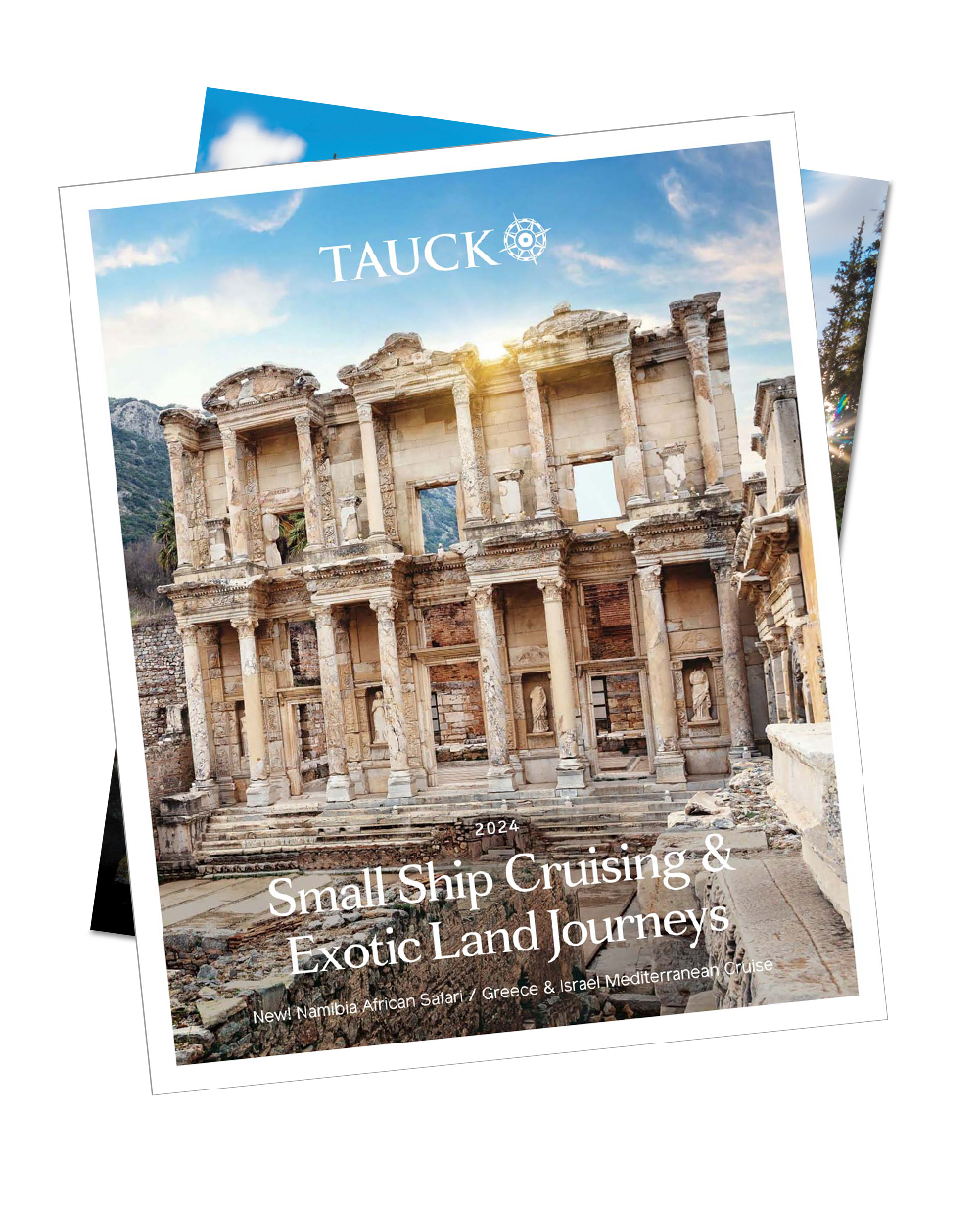
Related Journeys
Other Journeys You May Enjoy
Galapagos: wildlife wonderland.
From $7,590
Tauck Bridges Family Travel
- Destinations
- Antarctica & the Arctic
- Australia & New Zealand
- Israel & Jordan
- Latin America
- United States
- Tours & Cruises
- Exclusive Partnership
- Family Journeys
- Guest Favorites
- River Cruises
- Small Groups
- Small Ship Cruises
- Awards and Accolades
- Our History
- Tauck Impact
- The Tauck Difference
- The Taucker Blog
- About Tauck
- Media Center
- Tutorial Video
- Agent Connect
- Register Your Agency
- General Information
- Group Bookings
- Newsletter Sign Up
- Order an eGift Card
- Request a Brochure
- Tauck Forums
- Travel and Health
- Travel Protection
- Travel Updates
Sign Up to Subscribe to Our Emails
- Find Your Trip
- Vacation Ideas
- Travel Tips
Customized Costa Rica Vacations, since 1999.
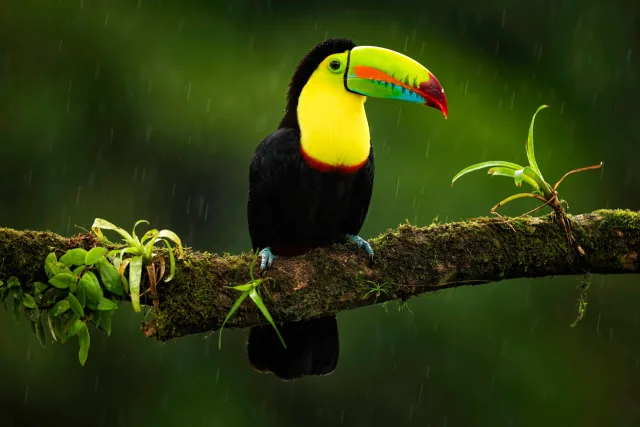
The Famous Toucan Bill
We live, work & travel in Costa Rica.
Every trip is designed for you.
5,000+ reviews from dazzled guests.
Virtual Tours
Join the toucan rescue ranch for a live virtual tour:.
Visit Toucan Rescue Ranch right from the comfort of our home! During the authentic experience you will have the opportunity to travel to Costa Rica and explore a the magic of Costa Rican wildlife. During this virtual experience, you will have the opportunity to interact with a knowledgable guide who can answer questions, show you up-close video of wildlife, and give you a full and exclusive tour of our facility! This is a great way to stay involved with Toucan Rescue Ranch while practicing safe social distancing during this unique time. All money raised from our virtual tours will be funneled RIGHT BACK to the care of the animals you'll get to meet - so you can feel good for hoping on ZOOM and learning all about our mission. We will see you soon!
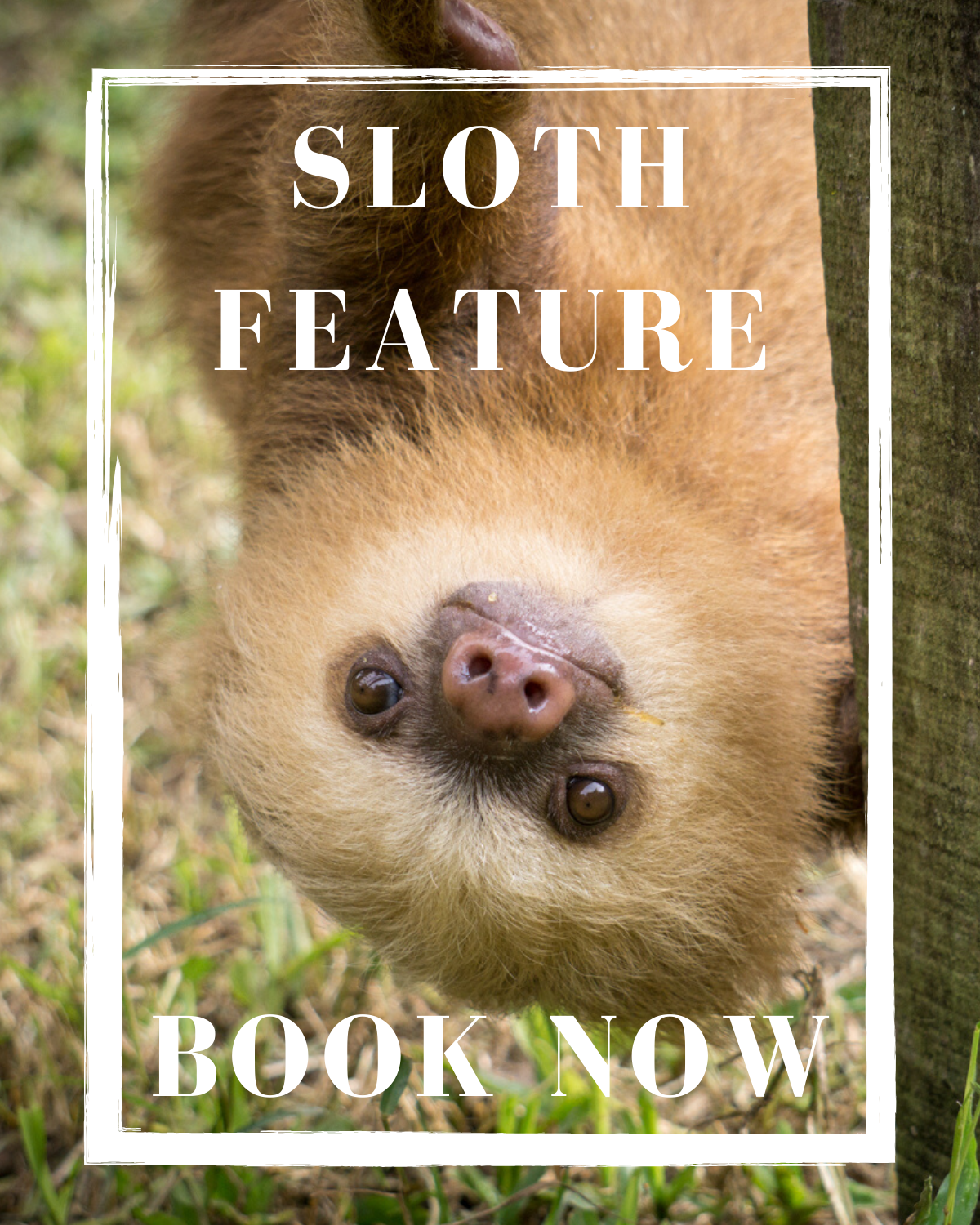
Sloth Feature Virtual Tour
You will receive a confirmation email with the zoom code on the day of your virtual tour. , duration: 1-hour, donation price: .
- General Admission: $25.00
- Kid Admission (12 and under): $12.50
MEET THE BABIES VIRTUAL TOUR
During this interactive virtual tour, you will sit and meet with our Founder and Executive Director, Leslie Howle! Learn from Leslie as she shares her personal journey creating the Toucan Rescue Ranch explaining its history, mission, and various exciting programs! SPECIAL for this tour ONLY, you will be able to watch how Leslie feeds orphaned baby sloths up close! She will walk you through how intricate it is to raise sloths and tell you each sloth's story as to why they are in Toucan Rescue Ranch's care. This tour will also teach you interesting facts about sloths and how you can protect them from home! Of course, you will have the opportunity for a LIVE Q&A with Leslie to ask her anything you want.
We encourage you to get some snacks or lunch while you enjoy the tour, that way will be having lunch alongside the rescued baby sloths! Interactive Q&A with your knowledgeable guide throughout the duration of your tour.
DURATION: 45 MINUTES
- General Admission: $85.00
- Kid Admission (12 and under): $42.50

Classic Ranch Virtual Tour
- General Admission: $20.00
- Kid Admission (12 and under): $10.00
CLASSROOM TOURS | Reserve Via Email
Please send an email to [email protected] to make a reservation. teachers will receive a confirmation email with the zoom code on the day of your virtual tour. , duration: 45 minutes, monday - saturday | (gmt-6:00) central time (saskatchewan), costa rican time, student price: $10.00.
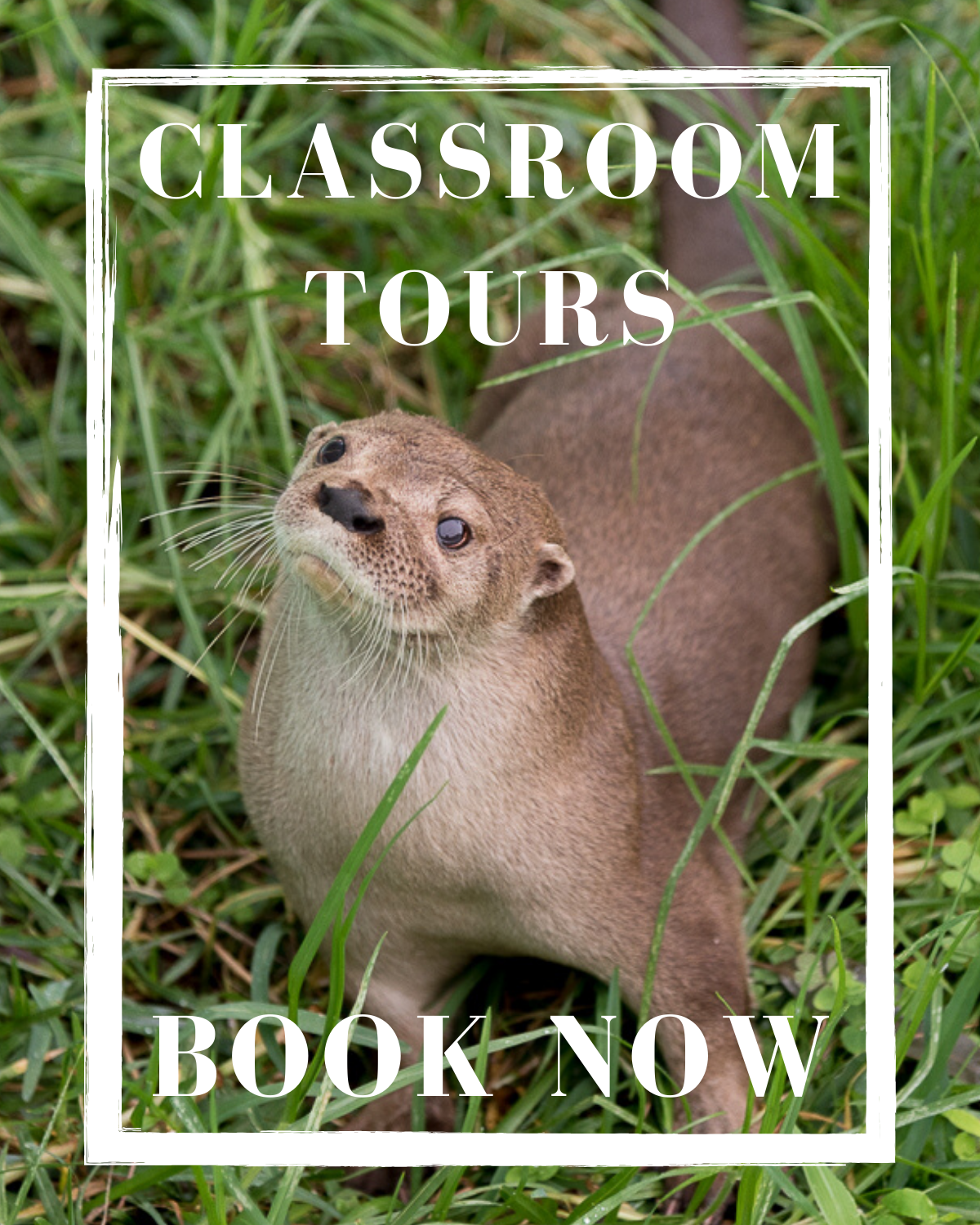
Purchase a Gift Card!
Looking for a birthday or holiday gift? Purchase a gift card for your loved one and support wildlife conservation! We are now offering gift cards good for all of the educational walks and virtual tours. You can choose how much you want to put on the gift card. The card is digital, so it's easy to send to friends and family across the globe.
For any questions please email [email protected]
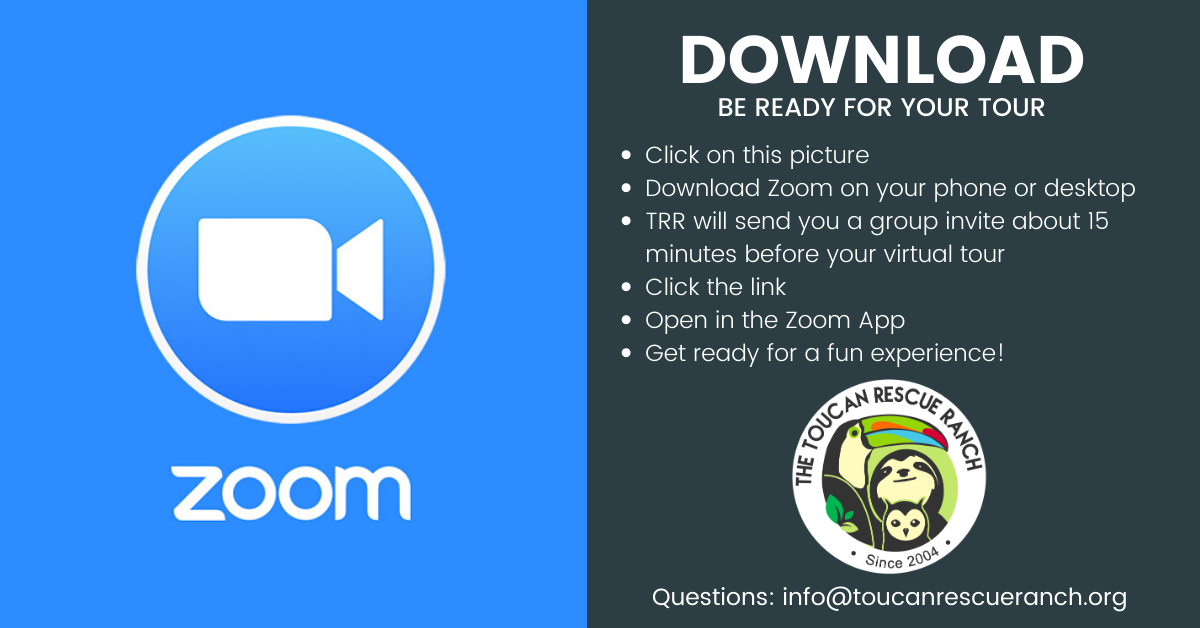

Best Places for Spotting Toucans in Costa Rica
by Joan Borreli | Apr 8, 2024 | Costa Rica Birding Blog
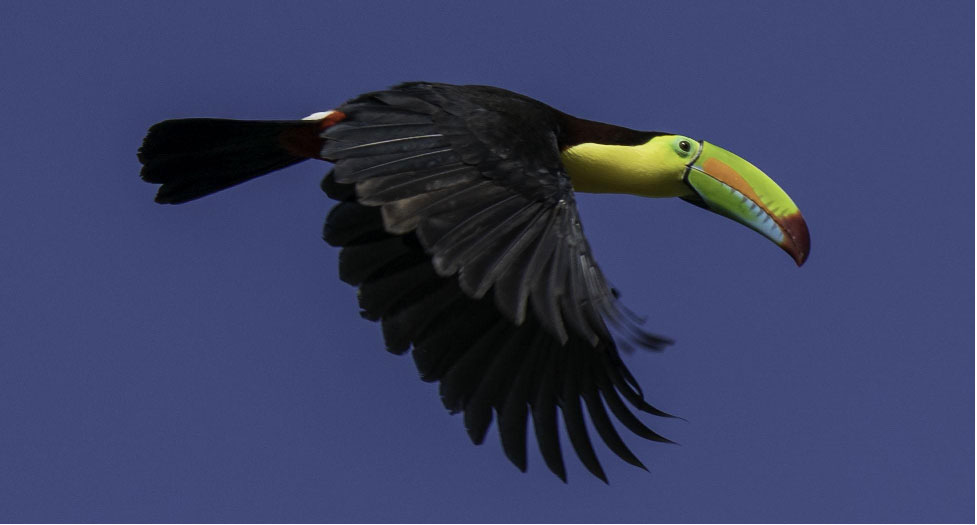
Costa Rica is renowned for its amazing biodiversity, beautiful landscapes, and of course birds.
One of the most popular species for birders and photographers to endeavor to see is the Toucan. With their colorful plumage, tell-tale beaks, and social behavior, toucans are sure to be found on all visitor’s target lists.
In this article, we’ll look into the world of toucans found in Costa Rica and explore their behavior, and the best places to see them in their natural habitat.
Introducing the Toucans of Costa Rica
Toucans belong to the family Ramphastidae. All species share the characteristic large, colorful bills, and colorful markings. In most species the large bill makes up ⅓ of their total body weight.
The bills are hollow, lightweight, which allows these magnificent birds to fly and glide through the sky, and hop through the treetops. Toucans use their bills for a variety of purposes, including feeding their young, regulating their body temperature, and, of course, attracting mates. The bill of Toucans has evolved over centuries to elongate and allow the Toucans to reach fruit and other food sources.
Toucans are only found in the New World, there are 42 species in total. Costa Rica has 6 different species of Toucans. They are Keel-Billed Toucan, Yellow Throated Toucan, Yellow-eared Toucanete, Fiery-billed Aracari, Collared Aracari, and the Emerald Toucanet.
Whether your trip takes you to the lowlands, mid-elevation, or highlands, there is at least one species of Toucan available to be seen or photographed.
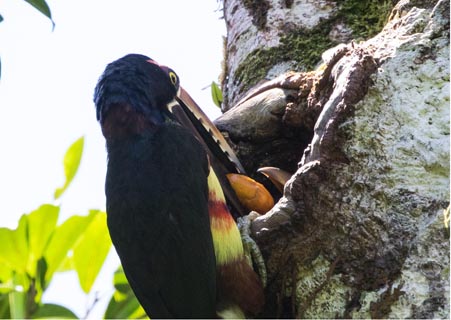
The diversity of Costa Rica’s jungles and forests provides the ideal habitat for Toucans. Toucans are arboreal, which means they live their lives in the trees. The trees provide the perfect place for Toucans to satisfy their well rounded diet. They will forage for nuts, insects and even small vertebrates. What they enjoy the most, though, are fruits. This is a very important part of forest regeneration. As Toucans eat fruit, they expel and disperse the seeds throughout the different areas they inhabit. Toucans are a vital part of keeping forests healthy and vital. It’s a symbiotic relationship between the bird, the food source, and the forest.
Where to find each Toucan species in Costa Rica:
Keel-billed toucan:.
The Keel-billed Toucan has one of the largest distributions of all Toucans. They can be found from Mexico to South America. This species is often referred to as “The Rainbow Billed Toucan”. Its colors are dazzling. In Costa Rica it can be seen from the Caribbean Lowlands to the Cloud Forest.
Some of the top locations for spotting this species are: Arenal, Monteverde, La Selva Biological Station and Tortuguero.
Keel-Billed Toucans are even known to visit fruit feeders so the chance for close sightings and great pictures are excellent.
Yellow Throated Toucan:
The Yellow Throated Toucan (formerly the Black-Mandibled Toucan) is the largest Toucan in Central America. It’s easiest to see in the lowlands of both the Caribbean and the Pacific sides of the country.
Some of the top locations to see this bird include: Carara National Park, Corcovado National Park, La Selva, and Cano Negro.
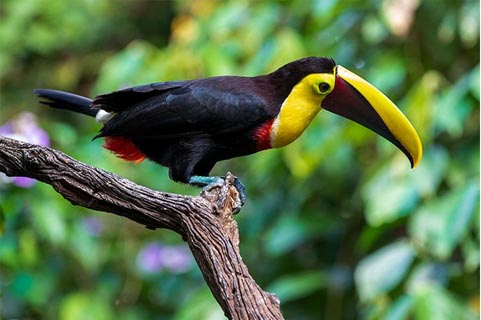
Fiery-Billed Aracari:
The Fiery-Billed Aracari is endemic to Costa Rica and Western Panama. This Toucan can be spotted in the South-west of Costa Rica. Recently this species has been expanding its territory and there are now sightings outside San Jose. Like all Toucans, they are cavity nesters. Birders and photographers can enjoy watching the antics of the Fiery-Billed Aracari darting in and out of their nests.
Collared Aracari:
The Collared Aracari is widespread from Guanacaste throughout the Caribbean. They are very common and most visitors will enjoy seeing this species in the forest and in fruit feeders. They are very social and usually travel in parent or family groups.
Blue Throated Toucanet (formerly known as Emerald Toucanet):
The Blue Throated Toucanet is a Mountain Toucan. It’s only found in the cloud forest. It is the smallest of all the species of toucans in Costa Rica. The vibrant emerald green color makes this species a favorite for photographers and bird watchers.
The best places to see this bird are: Cinchona Feeders, Monteverde, San Gerardo de Dota.
Yellow-Eared Toucanet:
This is the most difficult Toucan to see in Costa Rica. Its distribution is limited to a very narrow altitudinal belt on the Caribbean side of the mountains. It’s a secretive bird that sticks to the primary forest. Visitors will need to venture into the forest to get a look at this species. Unlike the other species of Toucans, who are quite vocal, the Yellow Eared is very quiet as it makes its way through the forest.
Best locations are: Braulio Carillo National Park, Arenal, and Rincon de La Vieja.
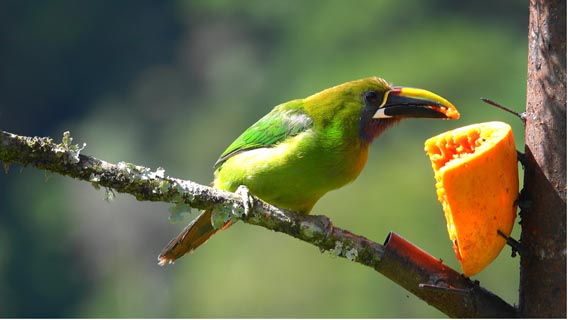
Planning an itinerary to find all six species of Toucans in Costa Rica:
If seeing the six species of Toucans in Costa Rica is on your target list we can help you put together a trip plan that will help you fulfill that goal.
We would suggest a trip of between 12-14 days. You can journey from San Jose to the Central Pacific, looking for the Collared Aracari, Fiery Billed Aracari and perhaps the Yellow Throated Toucan.
From there you’ll continue to the Talamanca Highlands and San Gerardo de Dota where you’ll be on the lookout for the Blue Throated Toucanet.
From San Gerardo de Dota you’ll head to the Caribbean Lowlands and look for the Keel Billed Toucan and the Collared Aracari.
From there you’ll make a stop at a very reliable spot for the Emerald Toucanet.
Next it’s on to Arenal and Monteverde, both great locations for Toucans (and other birds) and finally you can end your journey with a few nights in the Pacific North, to look for the elusive Yellow-Eared Toucanet.
Top Birding Lodges for Spotting the Toucans in Costa Rica
Hotel bougainvillea.
– Comfortable hotel, beautiful 10 acre gardens on site.
Villas San Ignacio
– Moderate hotel with wooded trails and a nice pool.
Central Pacific:
Tarcoles birding hotel.
– Moderate birding lodge with an exceptional location.
Nativa Reserve
– Deluxe condos with gorgeous views and fantastic birding on site.
Southern Pacific:
Corcovado wilderness lodge.
– The premier birding and wildlife lodge in Corcovado.
Drake Bay Wilderness Lodge
– Moderate lodge with good facilities and good birding.
Aguila de Osa Lodge
– Great location, easy access to the National Park.
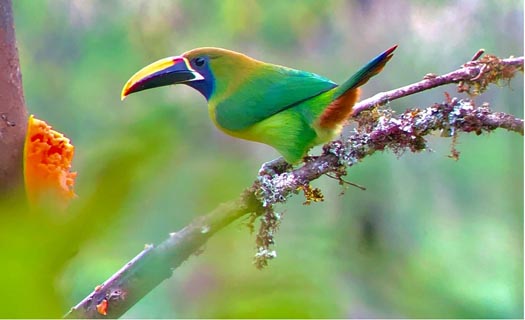

San Gerardo de Dota:
Savegre lodge.
– Excellent birding lodge with private reserve on site.
Quetzal Paradise Lodge
– Superb location for the Quetzal, and other species.
Toucanet Lodge
– Simple lodge with excellent birding.
Sarapiqui – Caribbean Lowlands:
Tirimbina lodge.
– Moderate but comfortable birding lodge with its on reserve.
Selva Verde Lodge
– Nice lodge with good trails on site.
La Quinta Lodge
– Nice lodge with trails and frog ponds on site.
Arenal Observatory Lodge
– The premier birding lodge in Costa Rica. A must stay in the area.
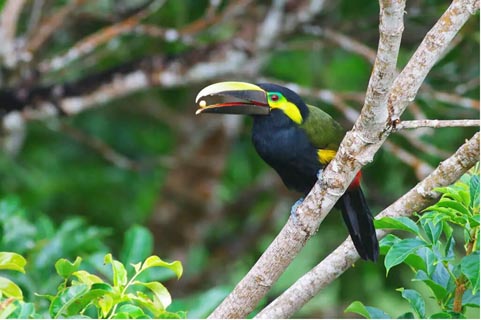
Monteverde:
Senda monteverde.
– Deluxe offering in the cloud forest. Reserve on site, great birding.
Heliconia Inn
– Moderate hotel with a good location, easy access to the reserves.
Guanacaste:
Borinquen lodge.
– excellent location for birding, wonderful facilities on site.
Hacienda Guachipelin
– Moderate lodge, but exceptional location and top birding on site.
If you are thinking about a birding trip to Costa Rica and would like to have a chance to see six incredible Toucan species click here to contact us. We will help you create an amazing trip plan focused on bird watching, photography, or both. We are looking forward to hearing from you, let’s get started, contact us here .

Birding San Jose Province Costa Rica – A Complete Guide
Costa Rica, a haven for biodiversity, is renowned for its rich array of flora and fauna,...
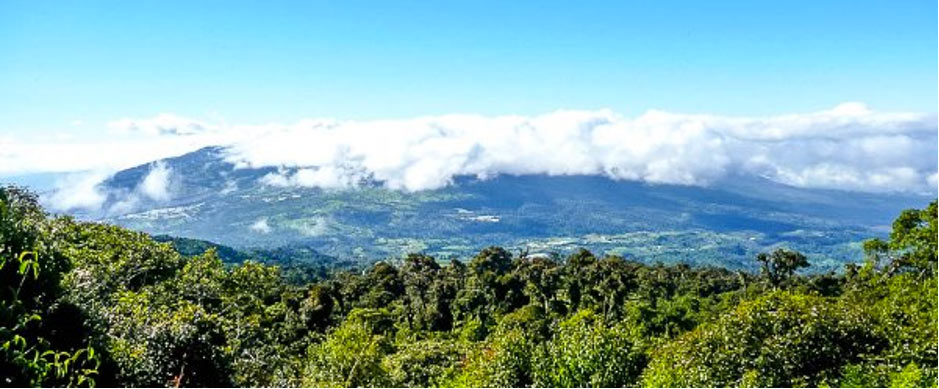
Birding Heredia Costa Rica – A Complete Guide
Nestled in the heart of Costa Rica, Heredia is a paradise for nature enthusiasts,...
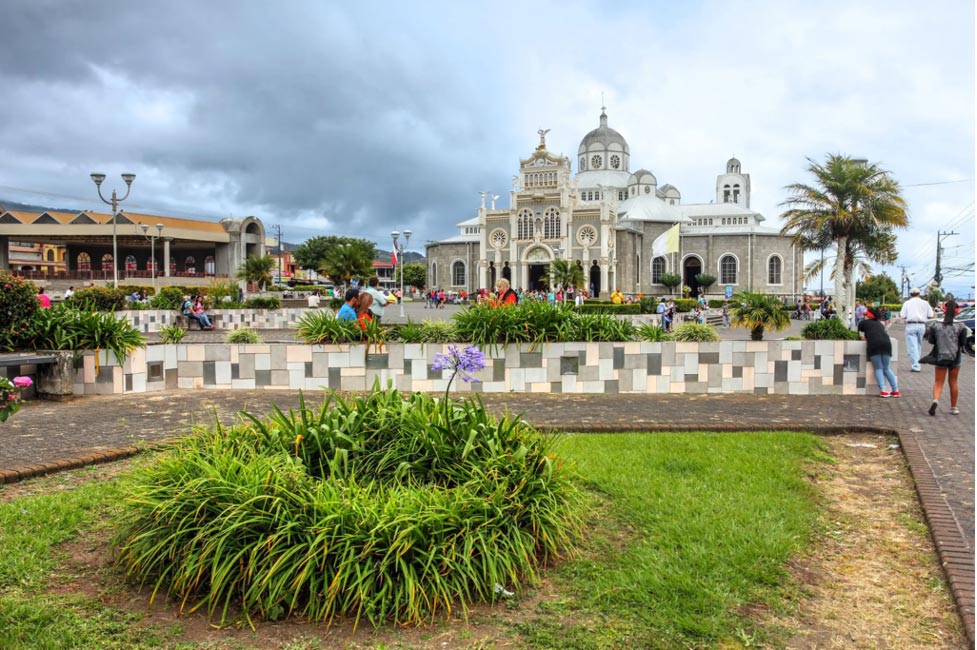
Birding Cartago Costa Rica – A Complete Guide
Nestled in the heart of Central America, Costa Rica is a natural wonderland that beckons...

Get a Free Quote for Your Birding Tour
Awards & accolades.

About Costa Rica Focus
Costa Rica Focus is a birding tour company that offers customized Costa Rica birdwatching tours for individuals or groups of people and guided by a knowledgeable birding expert who will help you spot and learn about the beauty of the birds of Costa Rica. Let’s talk about your Costa Rica birding vacation!
Quick Birdwatching Links
- Costa Rica Bird Photography
- Our Naturalist Guides
- Birds of Costa Rica
- Bird Checklist
- Privacy Policy
Contact Costa Rica Focus
(888) 788-4272
- Follow Follow
Tucan Terra

View prices for your travel dates
- Excellent 84
- Very Good 6
- All languages ( 90 )
- English ( 84 )
- German ( 2 )
- Spanish ( 1 )

" Pack everything you need, because it's a ways to the closest store. "
" I definitely recommend trying to stay upstairs, and be sure to stock up on food etc in town before heading out. "
" It's in the middle of the jungle. Bring enough food for the time you are staing. "
" Upper floor has great views "
" Upper level unit has a great view! "
Own or manage this property? Claim your listing for free to respond to reviews, update your profile and much more.
TUCAN TERRA
- Skip to primary navigation
- Skip to main content
- Skip to primary sidebar
- Skip to footer

Costa Rica Travel Information
Where to See Toucans in Costa Rica
January 30, 2018 By Sammi 3 Comments
Toucans are one of my favorite birds and if you are a bird watcher/wildlife photographer, Costa Rica is a great place to see them. There are 6 toucans in Costa Rica: Keel-billed toucan, Black-mandibled toucan, Yellow-eared toucan, Fiery-billed Aracari, Collarred Aracari and Emerald Toucanet.
In this post, you’ll find out some toucan facts and the best places to see toucans in Costa Rica. When it comes to spotting these birds, you will most likely hear them before you see them as they are quite vocal birds and have a unique call. We have seen 5 out of 6 toucans, just missing that sneaky Yellow-eared!
Costa Rica Toucan Facts
Toucans have oversized beaks, travel in small groups and are omnivores. They eat fruit, berries, insects and eggs/nestlings of other birds. They travel in groups and always in pairs when they’re adults. You’ll notice that toucans will exhibit a follow-the-leader behavior, whenever one toucan flies off, the others will follow a few seconds later so if you’re a wildlife photographer, you can predict which direction they are flying to and how long you have before they fly off again.
When their territories overlap, it is common to see different species of toucans together. We’ve seen Keel-billed, Chestnut-Mandibled and Collared Aracari toucans in the same tree!
Emerald Toucanet
Of the 6 toucans in Costa Rica, the Emerald Toucanet is the smallest standing at 12 inches (30 centimeters). This is the only toucan with a green chest and stomach and they are hard to see since they’re so small and bend in well in the trees.
They also have a distinctive dark blue throat, making them different than the other Emerald Toucanets found in Mexico and South America. Some classify them as a subspecies of the Emerald Toucanet and call them Blue-throated Toucanet.
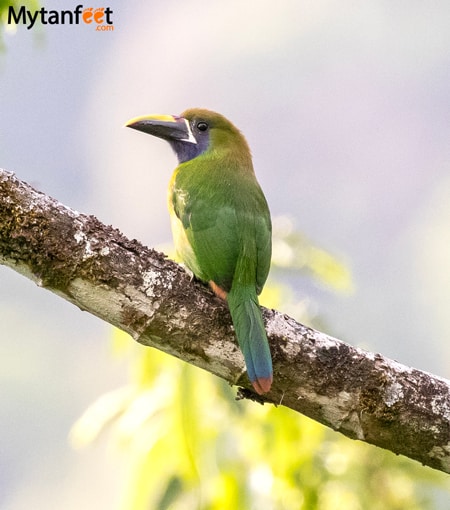
They’re live in elevations from 2600-8000 feet (800 to 2400 meters) and are commonly seen in Monteverde , Turrialba and in the Caribbean mountains. These toucans are also found in Nicaragua and western Panama.
We saw Emerald Toucanets in Monteverde at the Children’s Eternal Rain forest Bajos del Tigre station and around our Monteverde Airbnb. We also saw them up in the mountains of Turrialba, specifically the small community of Santa Cruz.
Collared Aracari
The Collared Aracari toucan stands 16 inches tall (41 centimeters) and look very similar to the Fiery-billed Aracari except for the mandible. The Collared Aracari has a white beak and a black belly stripe. They have in my opinion, the cutest call!
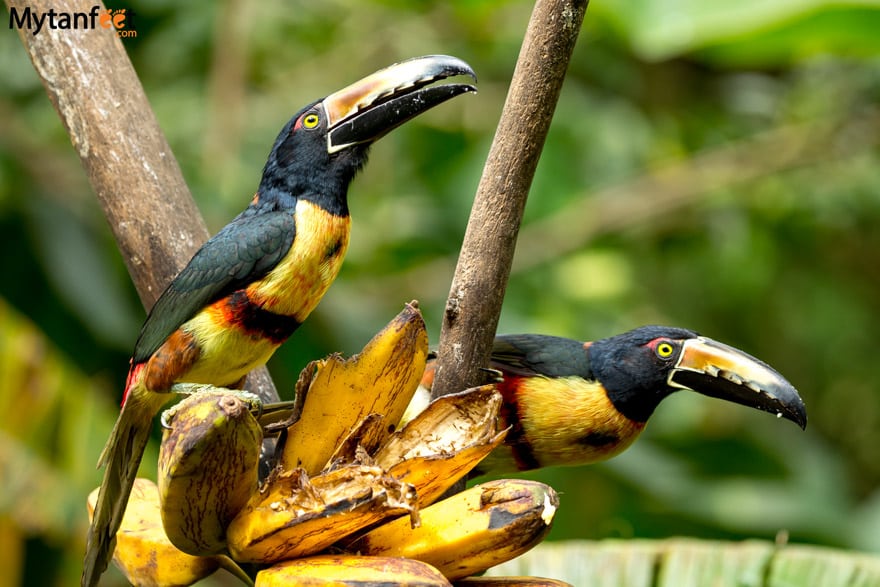
If you see one, you will most likely see more as they travel in groups of anywhere from 4-12. They are common in the mountains of Guanacaste, the Caribbean coast and the Northern Lowlands such as Arenal and Monteverde. They’re usually found in elevations up to 3000 feet (1000 meters).
We’ve seen Collared Aracari toucans in La Fortuna , Bijagua and Monteverde.
Fiery-billed Aracari
The Fiery-billed Aracari toucan has the coolest name! They look like the Collared Aracaris except for their chest and beak, which have red and orange stripes instead of white (hence the name Fiery). They’re around the same size as the Collared ones as well.
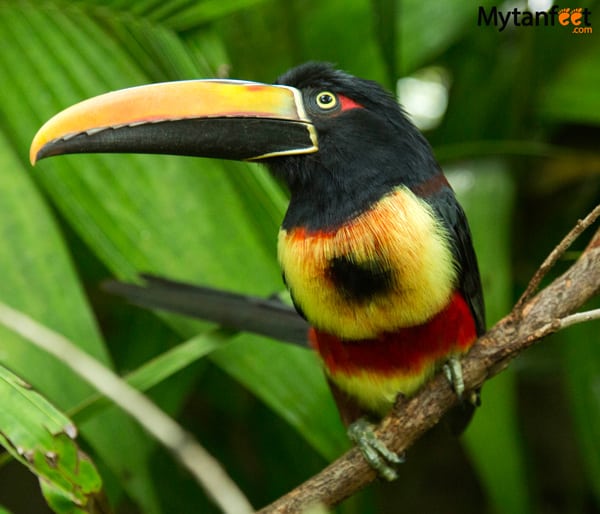
You can see Fiery-billed Aracaris only in the Central and South Pacific of Costa Rica so places like Manuel Antonio, Uvita and the Osa Peninsula. They are endemic to Costa Rica and western Panama and don’t usually live up high in elevation.
We’ve seen them in Manuel Antonio and Uvita. I absolutely adore the aracari toucans, their striking colors and call make them my favorites of all the toucans!
Yellow-eared Toucanet
The Yellow-eared Toucanet is the hardest toucan to see of the 6 in Costa Rica. As you can tell, I have yet to see and photograph one! This is the only toucan with a full black throat, breast and stomach but males and females are completely distinguishable (unlike the other toucans). Males have a yellow color on the side of their head whereas females do not.
Yellow eared Toucanets live in the the Guanacaste corridor to the Caribbean lowlands in elevations of 300 to 4000 feet (100 to 1200 meters).
I have talked to people who have seen them in Arenal and Monteverde. Hopefully I will be able to see one one day and photograph it!
Keel-billed Toucan
The Keel-billed toucan is the one most people relate to Costa Rica since it’s used as the symbol and logo for many companies. It’s also known as the Rainbow toucan because of the stunning colors of their beak.
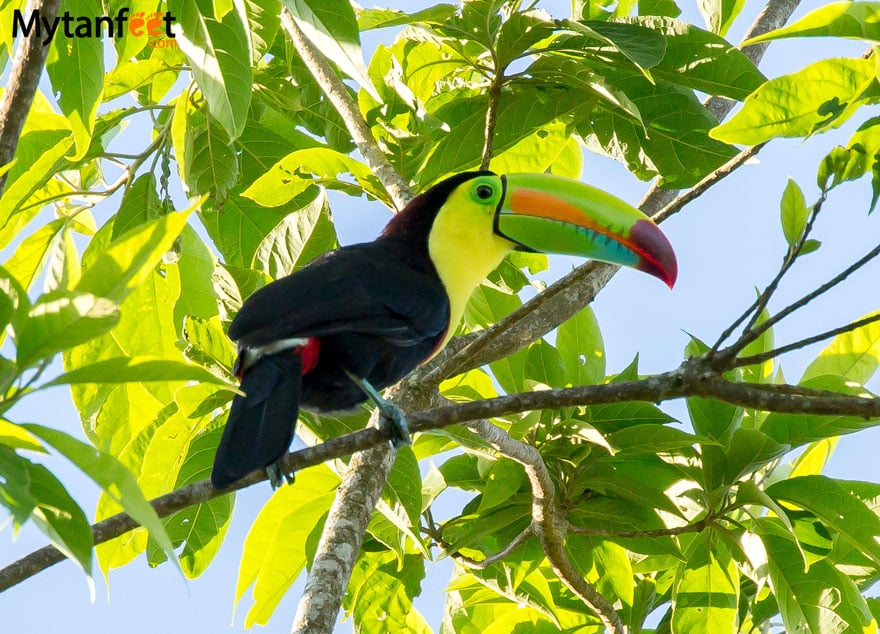
This toucan has the funniest call! Instead of a high pitch chirp, it has a croak which sounds like a frog!
You can see these toucans on the Caribbean side, in the Pacific coast mountains of Guanacaste, Monteverde, Turrialba, Cartago, mountains of the Central Valley and Arenal. They prefer an elevation of around 500-1500 meters.
We’ve seen these toucans at in Monteverde, Bijagua, Puerto Viejo , Tortuguero and Turrialba.
Black-mandibled toucan (or Chestnut mandibled toucan)
The Black-mandibled toucan is the biggest of the 6 toucans in Costa Rican and they are known as bullies. Since they are bigger than the others, they will bully the others for food and territory. For some reason, their name keeps changing too from Black mandibled to Chestnut.
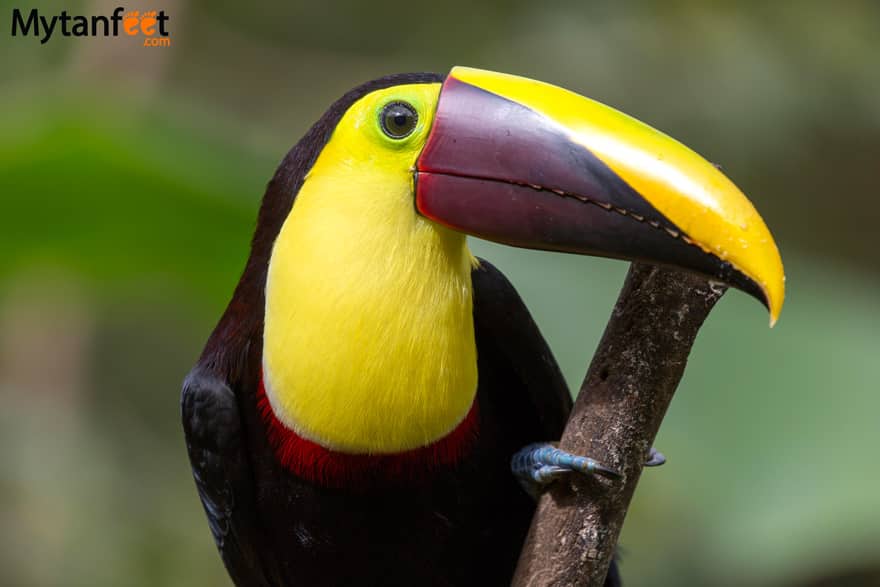
They have a high pitched call and are the most common toucans to see. They live in Arenal, Monteverde, mountains of Guanacaste (not the coast), the Caribbean side and the South Pacific.
Where to see Toucans in Costa Rica
To see toucans in Costa Rica, you don’t necessarily need to go on a bird watching tour. However, I do recommend it if you’re a birder or photographer. Some hotels are designed for bird watching in mind (observation tower, bird watching platform, etc.) such as Macaw Lodge , Danta Corcovado Lodge , Finca Verde Lodge, Selva Verde Lodge, Villas Lapas, Maquenque Lodge and Lapa Rios Lodge so check those out if you’re a bird watcher.
The best places for bird watching in Costa Rica are Carara National Park , Caño Negro Wildlife Refuge , Curi-Cancha Wildlife Reserve , Osa Peninsula, Gandoca-Manzanillo Wildlife Refuge and Tortuguero National Park.
One of the best bird watching experience we’ve had was actually at the Airbnb we stayed in La Fortuna . This house was out in the rain forest so we saw a ton of birds! We saw falcons, toucans, tanagers, motmots and hummingbirds of all sorts.
If you’re a photographer, don’t forget to bring a telephoto zoom lens (at least 400mm), a steady tripod and gimbal head to get those sharp photos. For our camera set up, I use a Canon 5d Mark III with a 100-400 mm lens and 1.4 extender . If it’s a sunny day, I’ll use the lens + extender on my Canon 80D which is a crop sensor so I can get even more length.
Read about other posts on wildlife in Costa Rica below!
Sloths in Costa Rica
Insects and spiders
Frogs and snakes
Costa Rica wildlife watching guide
Costa Rica Vacation Checklist
- First time to Costa Rica? Read our First Time in Costa Rica guide.
- Not sure how to move around Costa Rica? Read our How to Get Around Costa Rica guide to find the best transportation method for you.
- Click the link to get our detailed Costa Rica Packing List so you know what essential items to bring.
- Do not forget to purchase Travel Insurance for your trip to Costa Rica.
- Stay connected by purchasing a prepaid SIM Card in Costa Rica.
- Save money with Mytanfeet Deals for tours and hotels. Save more money with our Costa Rica Car Rental Discount.
Join our mailing list and get our free Costa Rica eBook!
There are affiliate links in this post.
Exclusive deals

The Osa Peninsula is coated in thick rainforests and winding rivers, home to near countless Costa Rican rainforest animals. © Brian Hutchinson
A trip to Costa Rica’s Osa Peninsula offers a guarantee for close encounters with a remarkable number of Costa Rica’s rainforest animals. The peninsula is renowned as a thriving bastion for all four of Costa Rica’s monkey species, tropical birds like the Scarlet Macaw, sloths, neon-colored frogs, and even sea turtles that come ashore to nest on the jungle-clad coastline.
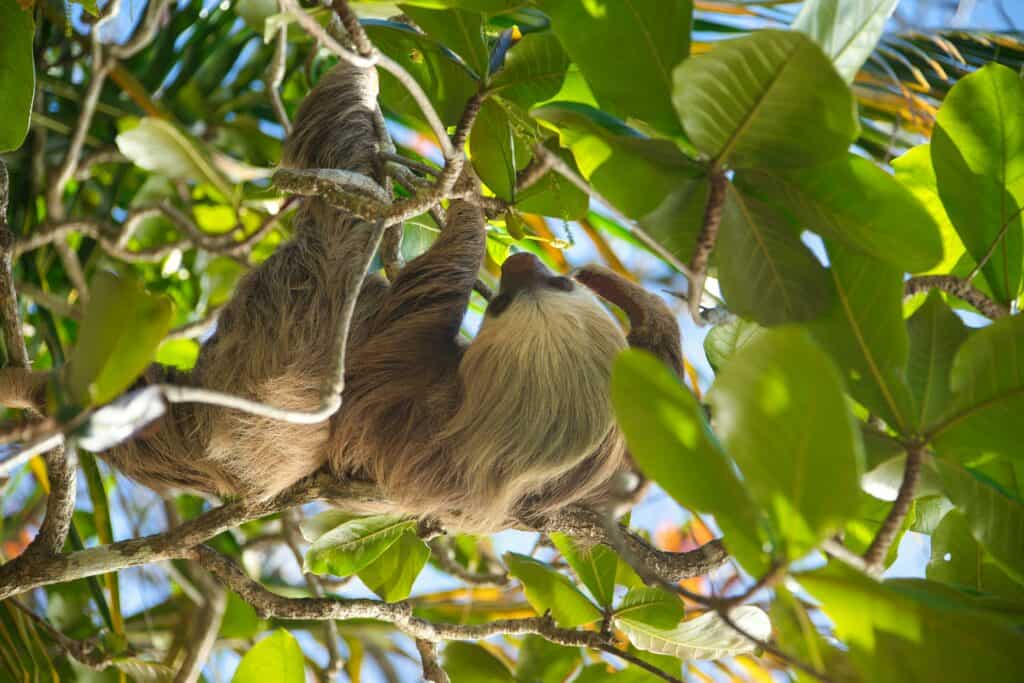
A two-toed sloth hanging among the canopy in a Costa Rica rainforest. © Koen Swiers
Sloths are perhaps the most famous Costa Rican rainforest animals, and Costa Rica may be the best place in the world to find them hanging sleepily from the treetops. Two sloth species make the Osa Peninsula their home: the two-toed sloth and the three-toed sloth. Both are famously slow (their Spanish name, perezoso , literally means “lazy”), survive mainly on tree leaves, spend nearly their entire lives dangling in trees, and are surprisingly good swimmers . Today, the three-toed sloth is about the size of a house cat, but their ancestors were once the size of elephants . While sloths can be very difficult to spot in the rainforest, nature guides are exceptionally good at finding them. One common method is to look for Cecropia trees, a conspicuous genre of tree that is found in pastures and secondary forest areas and is favored by sloths.
This adorable animal is a coati. Like raccoons, coatis are highly intelligent. © Brian Hutchinson
Coatis are a bit of a mashup of a critter, perhaps described as miniature raccoon with the face of a fox and a long feline tail. Whatever the description, they are exceedingly cute. Wild coati roam during the daylight and commonly wrestle with each other like playful dogs, and even hunt snakes. They are easy to find on the Osa Peninsula, particularly in cleared areas, like on the grounds of your lodge. Fun fact: when watched in reverse, coatis look like miniature dinosaurs .
A canopy walk is perfect for spotting Costa Rica rainforest animals, like birds, monkeys, and countless others. © Brian Hutchinson
Macaws & Toucans
With thick jungle covering much of the Osa Peninsula, it is unsurprisingly a birder’s paradise. Staying at a rainforest lodge and hiking through canopy trails provides travelers ample opportunity to spot some of the nearly 500 species of birds that can be found on the peninsula. Notably, the Osa Peninsula is the best place in Costa Rica (and among the best in the world) to see Scarlet Macaws .
Scarlet Macaws can be readily seen on Costa Rica’s Osa Peninsula. These colorful and charismatic birds mate for life. © Brian Hutchinson
The Scarlet Macaw is the largest of the parrot family and one of the most beautiful Costa Rica rainforest animals. Thanks to their large size, vibrant plumage, and raucous squawks they are hard to miss.
Big, colorful, and boisterous, Chestnut-mandibled Toucans are a delight to watch. © Brian Hutchinson
You may not need to work hard to spot the Chestnut-mandibled (aka Yellow-throated) Toucan , which is known to make appearances around the gardens of hotels. These banana-loving birds tend to travel with their mate during breeding seasons and are most famous for their bright, beautiful yellow and maroon bills, gentle caws, and neon plumage.
Living among the cloud forests, dry forests, and rainforests of Costa Rica are four iconic species of monkey, and all of them can be seen on the Osa Peninsula: the golden-mantled howler monkey , Central American squirrel monkey , Geoffroy’s spider monkey , and the white-faced capuchin monkey .
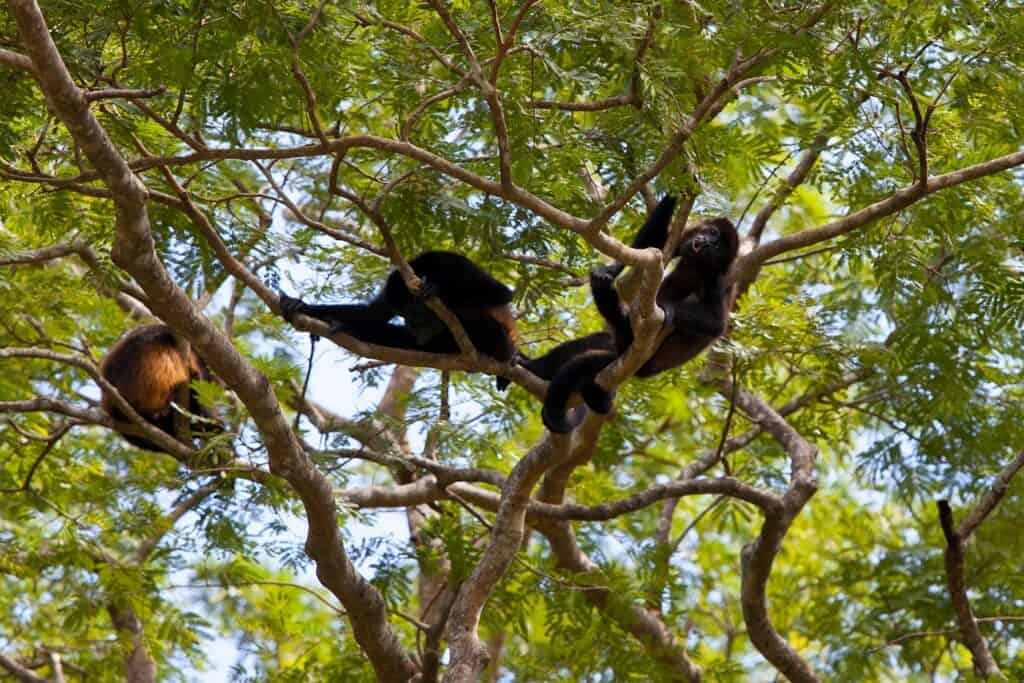
Howler monkeys are often seen (and heard) in the dry forest, living in large family groups. © Brian Hutchinson
The mantled howler monkey’s guttural call can be heard 3-miles away and is unmistakable above the jungle drone. Listening to their chants while lying in bed at an ecolodge or sipping coffee on a patio will quickly remind travelers of the wild that surrounds them.
A playful and inquisitive Squirrel Monkey. © Brian Hutchinson
The squirrel monkey is the smallest of the four monkey species in Costa Rica, only slightly larger than an actual squirrel. These charismatic and playful animals tend to travel in troops of 20-75 individuals, and are often seen by the dozens moving through the rainforest.

A spider monkey mother and baby on the Osa Peninsula. © Brian Hutchinson
Geoffroy’s spider monkeys are famous for their spindly limbs and long, muscular tails which can easily grasp branches, which along with their hands allow them to swing through the forest with grace . Due to habitat loss, the Osa Peninsula now offers one of the last and best bastions in the world to view this iconic species.
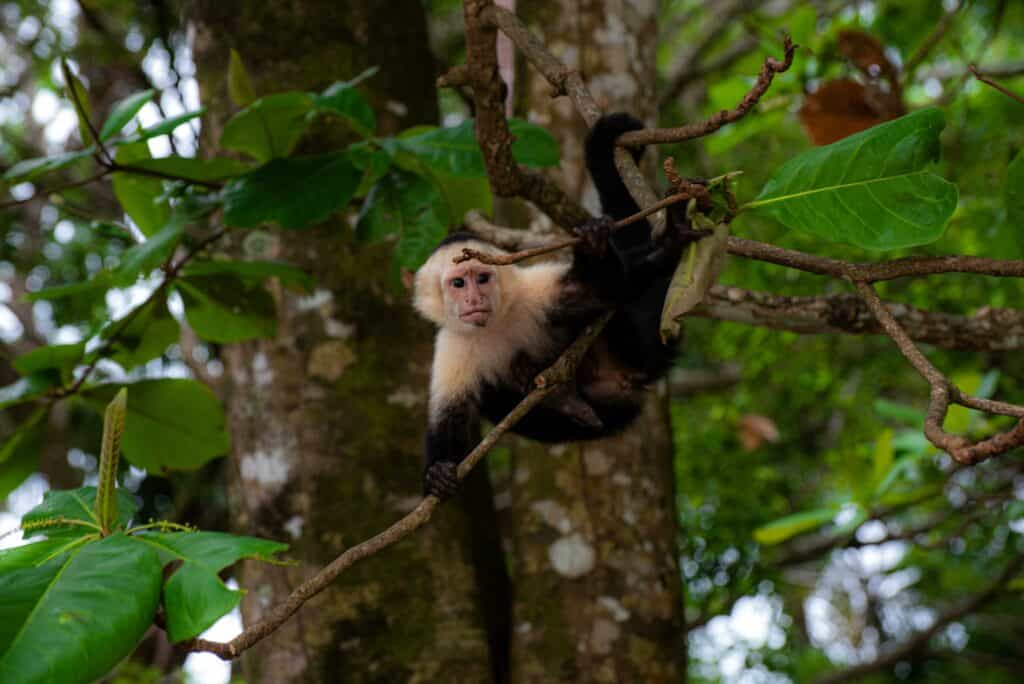
A white-faced capuchin monkey in the Costa Rican rainforest. © Andre Vujovic
The white-faced capuchin monkey is the most common of the four species in Costa Rica and can be readily seen on the Osa Peninsula. Not only are they famously curious, they are infamous for stealing unsuspecting tourists’ food. But that doesn’t mean tourists should feed them, in fact it is illegal . Doing so can harm their health, disrupt their natural diet, and cloud their survival instincts. Because the Osa Peninsula is largely wild and has relatively few tourists, white-faced capuchins are more likely to keep to themselves and behave naturally in their rainforest home.
Sea Turtles
The rainforest meets the sea on the Osa Peninsula. © Brian Hutchinson
Although it may seem odd to call sea turtles a Costa Rica rainforest animal, it’s hard to deny the connection between the rainforests of Osa Peninsula and the olive ridley sea turtles that come ashore to nest on wild beaches where the rainforest meets the sea. In fact, the Osa Peninsula is one of the few places on earth where jaguars (the rainforest’s top predator) are known to feast on nesting sea turtles .
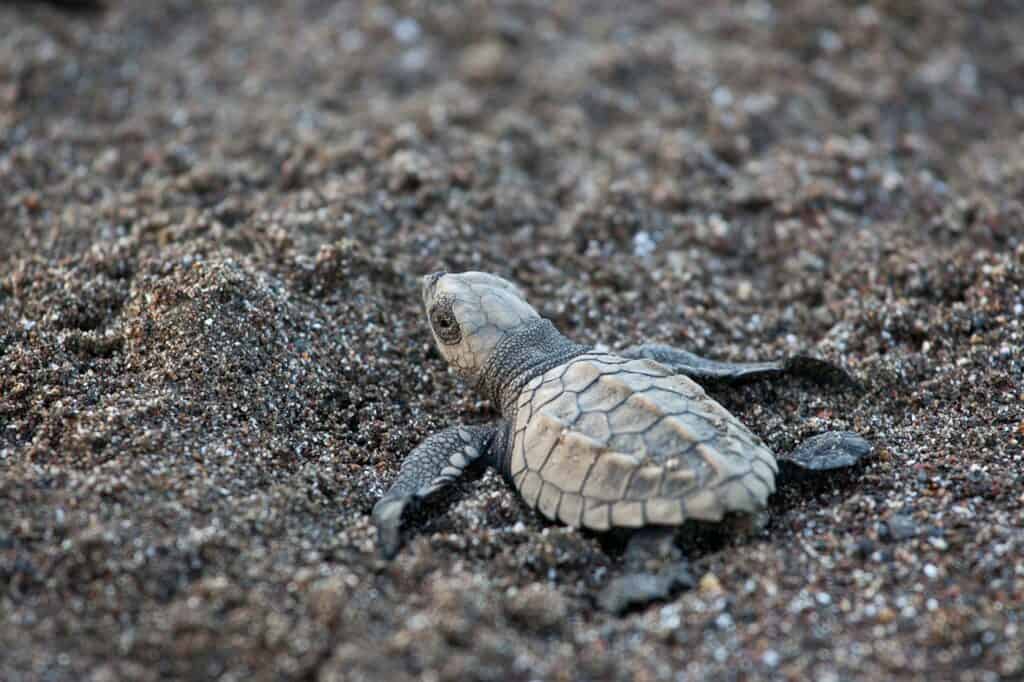
A newly hatched olive ridley sea turtle at Ostional. © Brian Hutchinson
Remarkably, sea turtles nest on the same beaches they were born . Those that live to adulthood will sometimes travel thousands of miles across the oceans over decades before returning to their birthplace to give birth to the next generation. With a little planning and the right itinerary , travelers to the Osa Peninsula can see newly hatched olive ridleys take their first steps as they make their way to the ocean.

A green and black poison dart frog on the Osa Peninsula. © Brian Hutchinson
Roughly 150 species of frogs are found in Costa Rica, including brightly colored poison dart frogs that stand out like jewels among the rainforest floor. Their neon patterns warn predators to keep away, as toxins on their skin can make them fatal to consume. The Osa Peninsula is a great place to look for poison dart frogs, red-eyed tree frogs, glass frogs, and other iconic amphibians of Costa Rica .
Tour the Osa Peninsula with Oceanic Society
These are just a few of the many wonderful rainforest animals that can be seen during a tour of the Osa Peninsula, which we consider a must as part of any Costa Rica eco tour itinerary.
Listen to the sounds of the jungle while perched on a cliff overlooking the Pacific, at the Bosque del Cabo hotel, Osa Peninsula. © Brian Hutchinson
Oceanic Society has been pioneering sustainable and ethical wildlife expeditions to the most biodiverse corners of the world for the last 40+ years. Our adventures immerse travelers in the most vibrant ecosystems while also supporting the economies and ecosystems we visit through our unique sustainable travel model . Each booking of a tour supports our nonprofit conservation work around the world as well as directly sponsors the removal of 200 pounds of ocean pollution .
Join us on an upcoming Costa Rica eco tour and you can not only experience the amazing wildlife of the Osa Peninsula up close, but do so in an ethical way that contributes to nature conservation in Costa Rica and worldwide.

Zach Theiler
Join our community., latest posts.
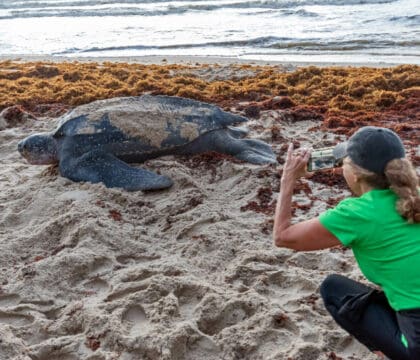
Sea Turtle Tourism Offers Opportunity to Observe and Interact While Having a Positive Impact

Meet Plaine Products: A Personal Care Company on a Mission to Reduce Plastic Waste
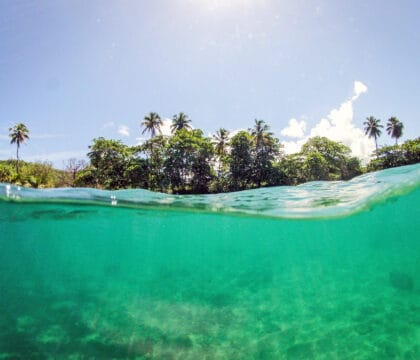
The Best Caribbean Snorkeling Destinations to Avoid the Crowds
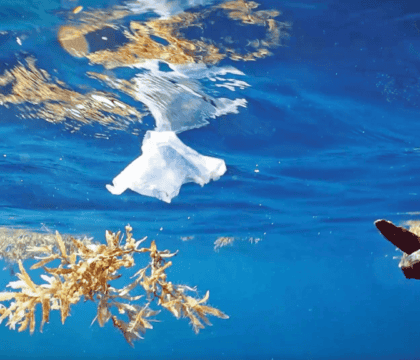
New Educational Video on Sea Turtles and Plastic Pollution
Adventure awaits..

Toucan Rescue Ranch: An Amazing Sloth and Wildlife Sanctuary
Posted on May 14, 2024
Categories Blog , Central America , Costa Rica , Kind Travel , Wildlife Tourism
Some sanctuaries out there aren’t all that they claim to be. They operate under the guise of “sanctuary” when they’re simply a tourist attraction looking to make money off the backs of captive wild animals. Thankfully, the Toucan Rescue Ranch is the real deal. This sanctuary does so much good and I’m so pleased to share this wonderful organization with you.
Admire and learn about rescued toucans, sloths and other wildlife. There isn’t a sloth selfie in sight. In fact, you’ll learn about all the reasons why you should never hug a sloth during an educational tour of the property. I took a tour of the Toucan Rescue Ranch and learned about their mission to rescue, rehabilitate and release animals back to the wild.
Posts may be sponsored. Post contains affiliate links. I may be compensated if you make a purchase using my link.

Table of Contents
About the Toucan Rescue Ranch
The goal of the Toucan Rescue Ranch is to rescue, rehabilitate and release Costa Rican wildlife back into the wild. The founders, Leslie Howle and Jorge Murillo, started the Toucan Rescue Ranch back in 2004 aiming to help toucans.

Many of the sick, injured, displaced and confiscated animals (victims of wildlife trafficking) come from the Costa Rican government agency, Ministry of Environment and Energy of Costa Rica (MINAE). When MINAE noticed how successful the toucan rescue and release program was, they brought more species of birds to the Toucan Rescue Ranch.
In 2007, MINAE brought its first sloth to the Toucan Rescue Ranch named Millie. With the introduction of Millie, Toucan Rescue Ranch transformed from a toucan rescue center into a multi-species wildlife rehabilitation center.
Nowadays, Toucan Rescue Ranch is home to many species of native wildlife, including wild cats, porcupines, kinkajous, weasels, parrots, monkeys and others. At its core, Toucan Rescue Ranch specializes in care for toucans, owls and sloths, with specialized rehabilitation programs for each.
In addition, Toucan Rescue Ranch has captive breeding programs for all six species of Costa Rican toucans. They also have breeding programs for owls, like native Striped Owls, Barn Owls, Pygmy Owls and Mottled Owls.
Toucan Rescue Ranch takes great care to only breed birds that are released into the wild, and these birds do not have human contact to ensure that they stay wild. They’re the only organization in Costa Rica (and second in the world) to successfully release captive-bred Emerald Toucanets.
An Educational Tour of the Toucan Rescue Ranch

The Toucan Rescue Ranch offers educational tours both onsite and virtually. When I traveled to Costa Rica, I visited the Toucan Rescue Ranch in person for a two hour guided tour.
You’ll need to purchase a ticket in advance from their website in order to take any of their tours. Please note that the sanctuary is closed on Mondays. You can take a tour in English or Spanish.

After a quick orientation and history about the Toucan Rescue Ranch, join your knowledgeable guide as you meet the permanent residents. You won’t meet any of the toucans, sloths or other wildlife that are being rehabilitated for release back into the wild. It’s important these animals have little to no human interaction so they can become wild once again.
The permanent residents at the Toucan Rescue Ranch serve as ambassadors for their species. A walk around the sanctuary introduces you to sloths, parrots, toucans, spider monkeys, weasels, cats and more.

The guides will teach you about the sanctuary’s mission and goals, as well as details about each individual species. You can also ask as many questions as you’d like on the way. This walking tour takes place in a beautiful garden with many native species of plants and flowers.

Of course, this is completely a “hands off” experience with no touching or handling of any wildlife, ever. I love how the Toucan Rescue Ranch is a leader in the #StopAnimalSelfies movement and highlights how its visitors can practice and embrace ethical wildlife tourism.
Partnership with the Sloth Institute of Costa Rica

Toucan Rescue Ranch has a partnership with the Sloth Institute of Costa Rica called Saving Sloths Together. By combining forces, the Sloth Institute of Costa Rica and the Toucan Rescue Ranch aim to provide every sloth with a second chance at living in the wild.
Their goals are three-fold: research initiatives regarding captive and wild sloths, collaborations with other sanctuaries and organizations that help sloths worldwide, and education about treating sloths responsibly to the general public.
Toucan Rescue Ranch has a program for rescue, rehabilitation and release that they call “Sloth University”. There are a number of different stages that a sloth must pass in order to determine whether or not they are a good candidate for release back into the wild.
There are many reasons why sloths become permanent residents at the Toucan Rescue Ranch. Some sloths rely on humans too much for food and care and will never be able to be released back into the wild. There are also many success stories of sloths living happily back in the wild after going through Sloth University.
Why Do Sloths Need our Help?

Sloths need our help. They need tall trees in order to survive. Habitat destruction and growing housing developments for humans are negatively impacting sloth populations.
Coupled with the illegal wildlife trade and sloths taken from the wild for roadside zoos, tourist selfies, and even as pets, sloths are in danger. While sloths aren’t an endangered species just yet, they are on the road to becoming endangered.
What can we do? Support organizations like the Toucan Rescue Ranch. Only give your tourism dollars to reputable sanctuaries when you travel to Costa Rica or other places in Central America. Don’t visit unreputable places that allow you to hold or hug sloths.
Why Should I Never Hold a Sloth?

You will not ever have the opportunity to hold or hug a sloth at the Toucan Rescue Ranch. This is for the well-being of the sloths, of course. If you ever visit a “sanctuary” or a zoo that allows you to hold or hug sloths, it’s an immediate red flag that this is not a good place for the animals and you should not support it.
I’m so grateful that the Toucan Rescue Ranch shares these facts about holding or hugging sloths with its visitors. Providing education is key. Most people don’t know that you shouldn’t hold a sloth and when presented with the chance, how could you resist? They’re so cute!
Please, never, never, never hug a sloth or take a selfie with a sloth. It is very stressful for a sloth to be touched by humans. Can you imagine how stressful it would be for them to be passed from human to human, hundreds of times every day?
Sloths are wild animals. They can bite or scratch you, which leads to transmitting zoonotic diseases. Sloths also become stressed by loud noises and sudden movements.
There is a sloth selfie problem on social media. Here are some startling facts:
- 70% of photos of sloths on Instagram are people hugging them or using them as accessories
- 110 million people visit tourist attractions that involve inappropriate animal contact each year
- 550,000 animals exist in captivity for photo opportunities
- Survival rate for sloths in captivity for selfies averages only 3 – 6 months
- Selfies with sloths promote animal cruelty and the illegal wildlife trade
- ALL sloths are taken from the wild
How to Recognize a Reputable Sanctuary

Just because a property is labeled as a sanctuary doesn’t mean that it actually is one. Unfortunately, there are many places that call themselves animal sanctuaries around the world that are far from it.
World Animal Protection has developed an easy to follow checklist to determine whether or not a sanctuary is genuine or not. Starting with the question of, “where do the animals come from”, we want to make sure that the animals are not taken from the wild unless they are injured.
Furthermore, they should not be in the business of buying and selling animals. The organization won’t breed animals unless they are being released into the wild to help their populations increase. Finally, the sanctuary will not accept more animals than it can properly manage.
The animals have proper care and access to veterinarians 24/7, and the staff members have the proper training to care for the animals on a daily basis. The sanctuary should never use wild animals for entertainment purposes (shows, tricks, rides, selfies and hugs) and they should not have animals to make a profit.
Simply put, a reputable sanctuary solely exists to help animals and provide care for them. The best sanctuaries take care of animals that cannot be released back into the wild, and rehabilitate and release the ones that can be.
In addition to the Toucan Rescue Ranch, I volunteered at ARCAS in Guatemala helping to rehabilitate rescued wild animals. They’re an amazing organization. If you’d like to volunteer helping animals in Guatemala, take a look at my blog post for more details and check out the volunteer program offered by Animal Experience International (this is what I did and I loved it!).
How to Help the Toucan Rescue Ranch

There are a number of ways to help the Toucan Rescue Ranch. Visiting this sanctuary provides tourism dollars and financial assistance for the rescue center. You can also donate or symbolically adopt an animal to donate towards its care. If you can’t travel to Costa Rica right now, sign up for a virtual tour through their website.
Toucan Rescue Ranch is looking for volunteers and interns! You must be able to commit to at least four weeks / 20 days of volunteering, though they prefer you to volunteer for a longer amount of time if it’s possible.
By volunteering, you’ll be working for the wildlife and providing care for the animals. Here are more details about the volunteer program at Toucan Rescue Ranch. While I haven’t volunteered here (I only visited for the tour), I’ve volunteered helping animals in Guatemala and Kenya in the past. It’s an extremely rewarding experience and I highly recommend it.
More Blog Posts About Costa Rica
Are you planning a trip to Costa Rica? Please take a look at our other blog posts about Costa Rica to help plan your adventures there:
- 20 Best Things to Do in Manuel Antonio
What About Travel Insurance? You should never leave home without it. Get a travel insurance quote in seconds with the best rates.
Follow Us on Social Media!

Lauren is the full-time travel blogger and content creator behind Justin Plus Lauren. She started Justin Plus Lauren in 2013 and has travelled to 50+ countries around the world. Lauren is an expert on vegan travel as one of the very first vegan travel bloggers. She also focuses on outdoor adventure travel, eco and sustainable travel, and creating amazing travel itineraries for cities and small towns.
- Work & Careers
- Life & Arts
Become an FT subscriber
Try unlimited access Only $1 for 4 weeks
Then $75 per month. Complete digital access to quality FT journalism on any device. Cancel anytime during your trial.
- Global news & analysis
- Expert opinion
- Special features
- FirstFT newsletter
- Videos & Podcasts
- Android & iOS app
- FT Edit app
- 10 gift articles per month
Explore more offers.
Standard digital.
- FT Digital Edition
Premium Digital
Print + premium digital, ft professional, weekend print + standard digital, weekend print + premium digital.
Essential digital access to quality FT journalism on any device. Pay a year upfront and save 20%.
- Global news & analysis
- Exclusive FT analysis
- FT App on Android & iOS
- FirstFT: the day's biggest stories
- 20+ curated newsletters
- Follow topics & set alerts with myFT
- FT Videos & Podcasts
- 20 monthly gift articles to share
- Lex: FT's flagship investment column
- 15+ Premium newsletters by leading experts
- FT Digital Edition: our digitised print edition
- Weekday Print Edition
- Videos & Podcasts
- Premium newsletters
- 10 additional gift articles per month
- FT Weekend Print delivery
- Everything in Standard Digital
- Everything in Premium Digital
Complete digital access to quality FT journalism with expert analysis from industry leaders. Pay a year upfront and save 20%.
- 10 monthly gift articles to share
- Everything in Print
- Make and share highlights
- FT Workspace
- Markets data widget
- Subscription Manager
- Workflow integrations
- Occasional readers go free
- Volume discount
Terms & Conditions apply
Explore our full range of subscriptions.
Why the ft.
See why over a million readers pay to read the Financial Times.
International Edition

15 Interesting Facts About Costa Rica
C osta Rica is a land of diversity. There are adventures for almost every kind of outdoor and nature enthusiast. Did you know that US News ranks Costa Rica #10 as one of the best countries for adventure?
What if you are looking for relaxation ? Discover some of the best beaches in Costa Rica.
Before you go, learn some of the interesting facts about Costa Rica that you may not already know along with Costa Rica highlights and tips for traveling in Costa Rica.
Costa Rica Highlights and Tours
Map of the guanacaste region of costa rica.
Guanacaste Region - Costa Rica Map courtesy of Google
Chris and I recently traveled to Costa Rica. It was our first time in the country as well as in Central America. Did you know that Central America is made up of 7 countries: Belize, Costa Rica, El Salvador, Guatemala, Honduras, Nicaragua, and Panama ?
These are some of the interesting facts about Costa Rica that we learned from our research. Hopefully they will help you in your planning and to have a fun and safe adventure.
1. Tap Water is Generally Safe to Drink
If you have traveled to many Latin American countries, you know that the water quality may be somewhat iffy.
Costa Rica is a country that thrives on tourism. The Costa Rican government works hard to provide clean drinking water in almost every part of the country. I F YOU ARE CONCERNED, you may want to stick with drinking bottled water.
As Chris and I returned happy and healthy from our trip to Costa Rica after drinking the tap water, using ice cubes in the restaurants, and enjoying smoothies, we are now happy to share our experience.
We drank water both from the tap at our vacation rental as well as from a filtered water pitcher. Both were fine, though the filtered water tasted just a bit better in my opinion.
At the Andaz Costa Rica Resort at Peninsula Papagayo, we drank water from the tap as well as the bottled water provided for free in our rooms each day.
Check Out My Travel Gear Recommendations on Amazon
2. Mosquitos Are Aplenty
One thing you don’t always think about is the need for bug spray in paradise . It is a must for your tropical vacation packing list and one of the very handy tips for traveling in Costa Rica.
I am a magnet for bites at home while my husband rarely gets bitten. After reading the recommendations from other travelers to bring bug spray, I did a little research and found the BUGGINS Original Gnat & Mosquito Insect Repellent with a light vanilla, mint and rose scent. I didn’t mind the smell at all.
Some tropical locations have mosquitoes and no-see-ums. Having been bitten by both, I prefer not to give those nasty bugs a chance.
I forgot to spray on bug spray for my last night in Costa Rica. After arriving home I began to notice small bites on my arms and legs.
3. You May Need a Rain Jacket
Although Chris and I traveled to Costa Rica at the beginning of the rainy season, we didn't see a drop of rain during our week-long stay. In fact, the weather was hotter than normal.
The rainy season is from May to November, and we traveled during the first week in May.
I would recommend tucking in a packable rain jacket just in case. Along with that, I would also suggest a waterproof cover for your backpack, especially if you carry expensive photography gear.
While Chris and I didn't experience any drastic changes in the weather, from what I could gather from my research, flash rainstorms are quite common.
We did take a day trip from the coast to a tropical rainforest and were sure to bring our rain jackets (just in case). The temperature was at least 15° cooler, but still pleasant. That takes me back to the previous tip however: be sure to wear bug spray!
4.Things to Know About Costa Rica if You Rent a Car
With our experience in choosing things to do in Guanacaste Costa Rica with excursions to Tamarindo, Playa del Coco, Plaga Langosta, Playa Hermosa, Rincon de la Vieja National Park, and the Papagayo Peninsula, I would definitely recommend renting a car.
If you choose to rent a car in Costa Rica, you will surely encounter Rental Car Insurance . Some agencies include the additional insurance in the quote when you rent online, and others will simply surprise you with it.
YOU ARE REQUIRED BY COSTA RICAN LAW TO ACCEPT THE MINIMUM RENTAL CAR COMPANY'S COLLISION DAMAGE WAIVER AND THIRD-PARTY INSURANCE .
This is regardless of the coverage you receive through your own credit card. You may, however, be given the option of different levels of coverage.
Chris and I opted for the minimum coverage . We had our rental car for one week, and the extra insurance added on approximately $150 to the total cost. If you aren't expecting this cost and haven't budgeted for it, you will definitely be surprised.
Manual-transmission vehicles are the standard . An automatic may be available, but you will need to request one in advance and they will most likely cost more to rent.
Is a 4x4 rental in Costa Rica a good thing? Yes. Yes. Yes.
Chris and I did not have a 4x4 and found that even getting up the hill to our vacation rental was a challenge in our low end car. Going back for another visit, we would definitely get a 4x4.
We also traveled over some very bumpy and questionable "roads". A 4x4 would have been so much nicer. There are limited options for local transport if you choose not to rent a car.
Additional Tips for Traveling in Costa Rica:
- Be a defensive driver and drive with caution
- Mountain roads are often winding and narrow
- You will find nicely paved roads as well as dirt roads that are bumpy and filled with potholes
- The assistants at the gas stations fill your gas tank for you
- Some roads are toll roads which require cash
- Police have been known to conduct routine stops to check documentation. You will need to show them your license and passport (to prove that you are driving within the time limit of your visa—30 days for tourists).
5. Carry Some Cash with You
Many of the places you stay, pre-booked attractions, and some restaurants will accept credit cards. It is a good idea, however, to exchange money for colones to be able to pay for those extras, some tips, and the local eateries that don't take credit cards.
6. Tipping is Not Mandatory in Costa Rica
Tipping is not mandatory in Costa Rica. You will find that many establishments already include a 10% tip or service charge. If you feel as though your guide, driver, hotel maid service, server, or excursion host has given you super service, tips are always appreciated.
The standard amount to tip in Costa Rica is 10% and you can give either Costa Rican colones or US dollars.
7. Costa Rica’s National Currency is the Colón
The national currency in Costa Rica is colones ₡. You may be able to pay for accommodation and tours in USD as well as with your credit card, but having local currency on hand to pay at local eateries and such may be required.
1 USD is approximately = 600 colones
Chris and I booked a couples massage while in Costa Rica. When booking, they requested that we have the necessary amount in local currency to pay in colones. If you are unsure, ask.
8. Sales Tax and Service Fees
In Costa Rica, it is required by law that restaurants include a 10% service fee that translates as a tip. Sales tax for restaurants, retails stores, and tourism services is currently 13%.
9. Tips for Traveling in Costa Rica: There is No Daylight Saving Time
One of the important things to know about Costa Rica is that it does not follow Daylight Saving Time . Costa Rica is located roughly 10 degrees north of the equator .
From March to November, the current time in Costa Rica is the same as Mountain Daylight Time in the United States. For Chris and I, there was no time change at all . Yay for no jetlag! From mid-March to mid-November, the current time in Costa Rica would be the same as Central Time in the United States.
Sunset occurs around 6:00 pm each evening and the sky start to get light in the morning around 5:00 am.
10. Pay Attention to the Seasons When Booking
Interesting facts about Costa Rica to know before you go? It has two tropical season: dry season and green season .
Dry season (also known as high season ) is from December to April . During these months, many tourists arrive in Costa Rica to enjoy the tropical weather. Green season aka the rainy season is from May to November .
Chris and I visited at the beginning of the rainy season. We did not experience any rain; in fact, the weather was unseasonably hot. Many of the locals that we talked with were anxious for some cooler weather and rain.
We did not experience heavy rain nor mud, but if you travel to Costa Rica during the rainy season months, you will want to be prepared for the weather and driving conditions. It is always a good idea to bring your rain gear with you, even if the skies start out blue in the morning.
As far as the best time to go to Costa Rica? I would say, "Whenever you can get away!" I would think the shoulder season would be ideal: April to May and November and December.
11. Learn Basic Spanish Phrases
Wherever you travel in this great big world, it is a good idea to have a few LOCAL words and phrases ready to go when you visit. The official language of Costa Rica is Spanish. As one of the best tips for traveling in Costa Rica, do yourself a favor and learn a few of these basics words and phrases:
- Hello - Hola
- Goodbye - Adiós
- Please - Por favor
- Thanks - Gracias
- You're welcome - Con Mucho Gusto
- Good morning - Buenos días
- Good evening - Buenas noches
- How are you? - Cómo estás?
- Pure Life - Pura Vida
One of the fun facts about Costa Rica? You will hear "Pura Vida" often as it r epresents Costa Ricans' relaxed attitude towards life . It can be used to say "hello", "goodbye", "everything is okay", and to brush off negativity. It is a way of life and an attitude.
12. Wildlife
Costa Rica is full of a diverse population of animals and wildlife.
As Chris and I followed our guide in the Rincon de la Vieja National Park and tropical forest, we were surprised when he showed us snakes, butterflies, a toucan, and insects.
We would have never known they were there.
We visited the Diamante Animal Sanctuary as well where we saw monkeys, butterflies, sloths, jaguars and more. Again, if you are hiking in the forest, you may never spot them on your own.
We did, however, see plenty of monkeys at Andaz Costa Rica Resort at Peninsula Papagayo. They were abundant in the trees around the resort. The first morning we saw them, we said, "Oh, how cute."
Turns out that some were howler monkeys! Important things to know about Costa Rica and monkeys: if they happen to be in the trees outside your hotel room as the sun goes down, you are in for a noisy night. The sounds coming out of these cute little monkeys is not so cute!
The most common creature that we saw while snorkeling was the sea urchin. While the water was not nearly so clear as the water in Moorea, Tahiti , there was still plenty to see in Costa Rica.
13. Fun Facts About Costa Rica: A "Soda"Isn't What You Think it Is!
One of things to know about Costa Rica is that a soda is a small eatery, much like a mom and pop restaurant. Sodas typically offer open-air seating, traditional Costa Rican food, and a relaxed vibe.
One of the best Costa Rica travel tips is to eat at a soda; it is an awesome way to immerse yourself in the culture while also saving a little money!
14. A Tour Guide is Worth the Investment
One of the benefits to a guided tour is having a guide who is accustomed to spotting the wildlife in nature that you would typically walk past without seeing.
Chris and I enjoyed a guided tour through the rainforest with Joaquin of Sensoria as one of our Costa Rica highlights. Our tour included a hike, waterfalls, time to relax in the thermal pools, climbing to the top of the viewing tower to see the volcano in the Rincon de la Vieja National Park, and lunch.
Joaquin, our guide, shared his expert knowledge of the rainforest, a few snake sightings ("Don't worry", he said. "Pit vipers aren't easily excited!" Yikes!), and was happy to take pictures for us.
15. Tips for Traveling in Costa Rica: WiFi is Available
As a forward-thinking country that relies on the tourism industry, Costa Rica is no stranger to technology. One of the important things to know about Costa Rica is that many populated areas have access to either cable or DSL high-speed Internet. WiFi is available free of charge in certain locations throughout the country.
Chris and I enjoyed great service at our vacation rental in Playa Hermosa as well as at the Andaz resort on the Papagayo Peninsula.
Travel and Photography Gear
Travel photographer in Norway
If you are hoping to “UP” your travel skills beyond using your camera phone (though I still keep mine handy), you will definitely need some upgraded camera gear.
- Canon Powershot G1 X Mark III – A point and shoot with Manual mode options
- Canon t8i plus a lens kit – Perfect for beginners
- Canon EF-S 18-135mm f/3.5-5.6 IS My favorite lens for the Canon t8i
- Canon 6d Mark II DSLR – An upgraded camera for intermediate photographers
- Canon EF 24-105mm f/4 L IS USM Lens for the Canon 6d Mark II
You can see more of my photography gear recommendations on my Amazon Storefront .
Frequently Asked Questions: Things to Know About Costa Rica
Should i be concerned about my valuables.
Don’t flash expensive jewelry, electronics, purses, or clothing. You'll want to do your best to blend in. Be mindful of handing over your phone to a stranger to take pictures for you. Really, if you have valuables that you are concerned about, just leave them home.
What is Costa Rica known for?
Costa Rica is famous for its incredible natural wonders, aromatic coffee, chocolate, Pura Vida lifestyle, beautiful beaches, wildlife, rainforest, volcanoes, mountains, delicious food, and progressive government.
What is the population of Costa Rica?
Approximately 5 million people.
Does Costa Rica have a military?
No. They do maintain small forces capable of law enforcement, but Costa Rica has no permanent standing army.
Are there volcanoes in Costa Rica?
Yes. There are over 200 volcanic formations. Of those, approximately 100 actually show signs of activity and only five are classified as active.
Love this Post? Pin it!
Final thoughts on 15 interesting facts about costa rica.
Clearly, these are not ALL the things to know about Costa Rica before you go. Be sure to check out my additional posts about Costa Rica highlights: the Guanacaste Region, the Andaz Costa Rica Resort at Peninsula Papagayo, and things to do at Playa Hermosa.
You may also enjoy these posts...
- Costa Rica Travel Tips: 10 Easy Answers to Your FAQ’s
- 20 Brilliant Things to Pack for a Beach Vacation
- Need Vitamin Sea? Top 10 Reasons for a Couple’s Beachside Getaway

- Planning Your Trip
Local Travel Agencies

(506) 2234-0934

AVENIDAS 10 Y 12,CALLE 35,CASA #27, LOS YOSES
Planning your Trip to Costa Rica
Suggested itineraries
Accommodations
Restaurants
Other Activities
Travel Tips
#EssentialCostaRica
Share your experience, .


IMAGES
VIDEO
COMMENTS
Group tours with Tucan Travel are suitable for both couples, groups and singles alike. We are experts in group tours to Costa Rica, with a total of 13 different itineraries. Our tours are modular with the longest tour taking 49 days, passing through Mexico , Belize, Guatemala, Honduras, Costa Rica and Panama.
We're an award winning company, having won 6 awards last year! 33 years young. We have been operating since 1987 - 33 years of taking Tucan Travellers across the world. Solo Travel. A whopping 60% of our passengers on our group tours are solo travellers. Responsible & Sustainable.
Tucanes Tours is a leading tour operator in Costa Rica serving Manuel Antonio, Jacó and the San José areas. Nationwide shuttles available. +506 2777-0775 / 1-800-213-5730 Info ... We are outdoor outfitters that not only cater to individual travelers and bespoke travel but also specialize in fulfilling the needs of Incentive Groups, Meetings ...
Your travel agent to Costa Rica. Tucan Tours is the leading Destination Management Company for Costa Rica. We offer complete tailor-made trips for our guests and your customers and specialize in customer satisfaction with a wide variety of nature and adventure tours throughout Costa Rica or assist in finding the perfect hotel, lodge or campervan for your trip.
The above image was created by Costa-Rica-Guide.com. We encourage you to check out their site for carefully curated information about Costa Rica. Keel-Billed Toucan (Ramphastos sulfuratus): Often referred to as the "rainbow-billed toucan" due to its vibrant and striking bill, the Keel-Billed Toucan is an iconic resident of Costa Rica's ...
Local Travel Agencies; Tucán del Pacífico Tucán del Pacífico, Puntarenas (+506) 8380-8008. EMAIL - Tucán del Pacífico Agencia de Viajes - Planning your Trip to Costa Rica ...
Tucan Costa Rica. Skip to content. Toll-free from US & Canada: 1-866-739-3913 - CR: +506 4032-9100 [email protected]. ... Costa Rica Travel Requirements; Weather; What to bring? Camino Travel. Camino Travel; About Our Dedication to Sustainable Tourism in Costa Rica; Job Opportunities;
Costa Rica is the number one destination for Adventure Travel. Would you like some adventure and adrenaline combined with nature and wildlife, Costa Rica is the perfect destination. Rafting. Canyoning. Tubing. Snorkeling. Hiking. Mountain bike. Horse-back riding.
The Toucans of Costa Rica. Chestnut-mandibled toucan, aka Swainson's toucan, aka Yellow fronted toucan ( Ramphastos ambiguus swainsonii ), Spanish - Dios-te-de. In English the Chestnut-mandibled toucan has more names than we can keep track of it may also be called the black-billed, Swainson's, or Yellow-fronted toucan.
Villa Tucan is a small slice of jungle paradise located in La Fortuna, Costa Rica. Here you'll find the perfect blend of everything nature has to offer and a prime location near all the main attractions of the area. Come enjoy a calming atmosphere with your significant other, friends or family while exploring the region's magical sights and ...
See your travel advisor, or call Tauck at 800-468-2825 to make a reservation. At the time of booking, please have the following information ready for all members of your party: Tour Name and Departure Date. Traveler's Name: First and last names as they appear on your passport or driver's license.
Species & Where to See Them. There are six species of toucan in Costa Rica: Keel-billed toucan. Yellow eared toucanet. Black mandibled toucan. Fiery billed Aracari. Emerald toucanet. Collared Aracari. All the 6 species mentioned can be found in the rainforests around the country and they generally live in small groups.
During the authentic experience you will have the opportunity to travel to Costa Rica and explore a the magic of Costa Rican wildlife. During this virtual experience, you will have the opportunity to interact with a knowledgable guide who can answer questions, show you up-close video of wildlife, and give you a full and exclusive tour of our ...
Its colors are dazzling. In Costa Rica it can be seen from the Caribbean Lowlands to the Cloud Forest. Some of the top locations for spotting this species are: Arenal, Monteverde, La Selva Biological Station and Tortuguero. Keel-Billed Toucans are even known to visit fruit feeders so the chance for close sightings and great pictures are excellent.
Telephone. (506) 2743-8140. Email. [email protected]. Address. Bahía Ballena 100 m este del BCR, Uvita de Osa 60504 Osa. Quantity Of Rooms. 6. Services.
Tucan Terra, Cabo Matapalo: See 90 traveler reviews, 176 candid photos, and great deals for Tucan Terra, ranked #1 of 1 B&B / inn in Cabo Matapalo and rated 5 of 5 at Tripadvisor. ... by the troops of Spider, Howler, and White-Faced Monkeys. Yes, all 3 species were there to see every day! We also saw Costa Rica's 4th monkey species, the ...
Local Travel Agencies; Toucan Discovery Toucan Discovery. Mata Redonda: Oficentro La Sabana, Sabana Sur, Torre 6, piso 7, oficina # 26., San José +506 8777-7166. EMAIL. WEBSITE - Toucan Discovery - Planning your Trip to Costa Rica ...
There are 6 toucans in Costa Rica: Keel-billed toucan, Black-mandibled toucan, Yellow-eared toucan, Fiery-billed Aracari, Collarred Aracari and Emerald Toucanet. ... Mytanfeet is the leading Costa Rica travel information website with detailed guides, local recommendations, photos, videos and maps. Search on Mytanfeet.
A trip to Costa Rica's Osa Peninsula offers a guarantee for close encounters with a remarkable number of Costa Rica's rainforest animals. The peninsula is renowned as a thriving bastion for all four of Costa Rica's monkey species, tropical birds like the Scarlet Macaw, sloths, neon-colored frogs, and even sea turtles that come ashore to nest on the jungle-clad coastline.
By combining forces, the Sloth Institute of Costa Rica and the Toucan Rescue Ranch aim to provide every sloth with a second chance at living in the wild. ... Only give your tourism dollars to reputable sanctuaries when you travel to Costa Rica or other places in Central America. Don't visit unreputable places that allow you to hold or hug sloths.
We provider of meeting, event services and coordination, offers luxury chauffeured transportation Costa Rica. USA MIAMI CALL US (305) 320-5332 +506 8883-9115; Email: [email protected]; Toggle navigation. Home; About Us; ... Tucan Limo Services - Travel Agency and Tour Operator Costa Rica. Amazing places and spots to visit ...
Along Costa Rica's Caribbean coast stretch two important national parks. To the south lies Cahuita (great for sloth-spotting), a few miles from the laid-back beach town of Puerto Viejo de Talamanca.
Puntarenas. (506) 2777-07-75. EMAIL. WEBSITE. - Rancho Los Tucanes Nature & Adventure Tours Agencia de Viajes Receptiva -.
One of the best Costa Rica travel tips is to eat at a soda; it is an awesome way to immerse yourself in the culture while also saving a little money! 14. A Tour Guide is Worth the Investment
Local Travel Agencies; Tucan Tucan, (506) 2234-0934. EMAIL. AVENIDAS 10 Y 12,CALLE 35,CASA #27, LOS YOSES Planning your Trip to Costa Rica Suggested itineraries ...